Rachael Dickzen's Blog, page 4
October 21, 2020
An Abundance of Kateryns/Katherines/Catherines: Part 1!
I recently wrote a blog post on “My Favorite Thomases,” giving a little overview of numerous Tudor Thomases and ranking them somewhat arbitrarily. I had such a good time doing this, that I’ve decided to write a few more blog posts ranking various Tudor/English medieval people, because their parents were all unimaginative and kept giving them the same damn names! Expect future posts on Henrys, Marys, Edwards, Margarets, Richards, etc.
Today we’re moving to the ladies, and more specifically, AN ABUNDANCE OF (C/K)ATHERINES. (homage to John Green definitely intentional). I’m actually dividing this post into two parts so that I can finally start getting out the results to y’all, as this was one of my most popular posts on Facebook ever. (Yes, I’m taking a long time to write these. Sorry. Pandemic has shredded my ability to focus so research and writing right now is rather difficult).
THE PEOPLE’S VOTE:
Let’s start off with the people’s vote. I asked for people’s votes on 11 different Katherine/Catherines/ Kateryns from the Tudor era/important to the Tudor era (my original list actually had a few additional options, but I had to pair it down because I wasn’t going to write about like, 17 people, y’all, there aren’t enough hours in the day). These votes were compiled from comments on my author page, Traveling with the Tudors, Tudorinos, Tudor Renaisance and Reformation History, The Tudor Era, and Everything Tudor Era. If a commenter voted for more than one person, I took the first person listed as their vote, and kept the secondary votes for tie breakers (although that didn’t help in one specific area).
I’m only announcing Katherine/Kateryns 11-6 today. The Top 5 will be announced in part 2! I should note that the people’s vote was pretty close to my own personal ranking in distribution of people into the bottom 6 vs. the top 5. There’s only one Katherine in the bottom 5 of the people’s vote that I put in the top 5 of my own ranking and vice versa.
11/10/9. Tied for last: Katherine Woodville, Duchess of Buckingham: 1; Lady Kateryn Gordon of Scotland: 1; Katherine Willoughby: 1
8. Lady Katherine Grey: 1 (2nd votes - 1)
7. Queen Katheryn Howard: 2
6. “Kat” Ashley: 2 (2nd votes - 1)
RACHAEL’S RANKING:
And here we get to a little bio of each person and MY ranking. While a significant deciding factor of the “Thomases” ranking was a look at how terrible/good they were, I really can’t say that any of these Katherines/Catherines did any super terrible things. The ones ranked lower were really just less interesting to me than the ones at the top, or perhaps made decisions I consider a bit more careless or stupid.
Quick Note: As I’ve noted before, spelling of names was not standardized in Tudor times at all. Plenty of people spelled their own names in several different ways on different documents or just as the whim hit them. So honestly, I’m not fussing over the exact spellings of each name, although I’ve endeavored to use the name that the person themselves used most often.
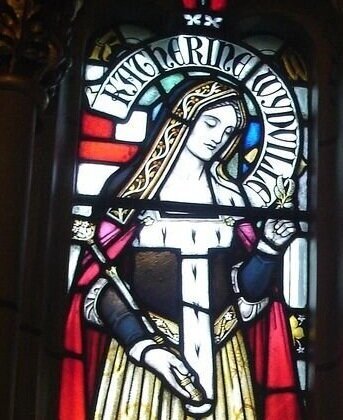
Katherine Woodville
11. Katherine Woodville, Duchess of Buckingham (through her first husband, Henry Stafford), Duchess of Bedford and Countess of Pembroke (through her second husband Jasper Tudor) (c. 1458-1497)
Summary: She outlived two husbands, survived three different kings, was immensely wealthy most of her life, and had some fairly notorious children.
- Katherine Woodville was a sister to Elizabeth Woodville and brother-in-law to Edward IV. She served her sister the Queen in the mid to late 1460s; her husband was in Queen Elizabeth’s custody as well during this time and lived in her household.
- Katherine married Henry Stafford, Duke of Buckingham while they were both children (she was likely around 7 and he was around 10); contemporary accounts of her sister Elizabeth’s coronation indicated that both Katherine and her husband were still small enough that they were carried on the shoulders of squires. The duke of Buckingham reportedly resented his marriage to a woman of inferior birth, but the couple still had 4 children together (and possibly more that didn’t live to adulthood). They were married for 13 years or so before they had any children together.
- Her first husband Henry Stafford was initially a close ally of Richard, Duke of Gloucester, when he usurped the throne from his nephews. However, Katherine did not attend Richard’s coronation, likely due to his hostility toward the Woodvilles. Henry Stafford later betrayed Richard III and was executed for treason in November 1483. Katherine and her children may have gone on the run after his death, but Katherine was quickly captured along with her younger son Henry and brought to London. Although the Duke left his wife a sizable jointure of 1,000 marks in his will (roughly equivalent to 460,430 pounds today, I figured out, using the UK National archives currency converter - this was the equivalent of 22,201 days of wages for skilled tradesmen), Katherine was attainted by Parliament because of his treason and was thus, deprived of his money. Her eldest son was kept in Richard’s custody. It is unknown where Katherine spent the remainder of Richard III’s reign, but she may have lived with her sister the Dowager Queen in sanctuary or in a trusted nobleman’s household. Richard did grant her a small annum of 200 pounds in April 1484 (roughly equivalent to 138,257 pounds a year).
- After Henry VII defeated Richard III and took the throne, her two eldest sons were placed in the wardship of the king’s mother, Margaret Beaufort, and they grew up in her care. Katherine’s attainder was reversed by Parliament and she received both her dower lands and the jointure her first husband left her in her will, making her an exceedingly wealthy woman. Katherine married the king’s uncle Jasper Tudor in 1485, when she was about 27 and Jasper was 54. Katherine was given a place of honor at her niece Elizabeth of York’s coronation in 1487, riding in the first chariot behind the queen’s in the procession to Westminster Abbey and sitting at her left side in the banquet afterward. After ten years of marriage, Jasper died. Katherine was only mentioned briefly in his will.
- Only a few weeks after Jasper’s death, she married Sir Richard Wingfield without royal license. Henry VII fined them a huge sum of 2,000 pounds, which was not paid until Katherine’s eldest son became Duke of Buckingham and came into his inheritance. Her third marriage lasted only about a year before she died in 1497. Although Richard Wingfield would outlive her by about 27 years, in his will, he ordered masses be said for her soul.
- Her eldest son Edward Stafford (Duke of Buckingham) was executed by Henry VIII for treason, continuing in his father’s footsteps. Her younger son Henry Stafford (Earl of Wiltshire) was also suspected of conspiring with his brother, but managed to stay in the king’s good graces until his death a few years later in 1523. When he died without children, his earldom became extinct. His title was granted a few years later to Thomas Boleyn.
- Her daughter Anne had a bit of a sex scandal under Henry VIII and was rumored to be having an affair with the king’s courtier William Compton. Her husband was so suspicious of her that he sent her to live in a convent 60 miles away from the royal court. Although there was no evidence of their adultery, William Compton actually did bequeath land for her in his will (which was very unusual for the time) and had the executors of his will include her in prayers for his kin.
- Katherine Woodville is also the name of a film and television actress active in the 60s and 70s who appeared in The Avengers, Mission Impossible, and Star Trek!
(Many thanks to the Freelance History writer for their article on Katherine Woodville and Kateryn Gordon, which were fantastic sources of information!)
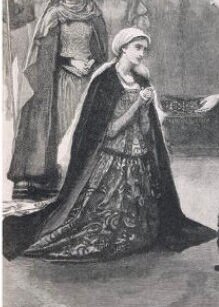
Kateryn Gordon
10. Lady Kateryn Gordon of Scotland (also known as Kateryn Huntleye) (c. 1474-1537)
Summary: She outlived three husbands and served three separate Tudor royal women (Elizabeth of York, Catherine of Aragon, and Mary Tudor), despite first coming to court as the wife of a rebel leader.
- Kateryn was a Great Granddaughter of James I of Scotland and a cousin of James IV.
- James IV gave her in marriage to the Yorkist pretender Perkin Warbeck, who quickly gained his favor upon his arrival at the Scottish court in July 1495. Warbeck claimed to be Richard, Duke of York, the younger of the “Princes in the Tower” and the son of Edward IV and Elizabeth Woodville. After their marriage in January 1496, Kateryn was known as the Duchess of York. Their marriage was celebrated with a jousting tournament.
- Her husband Warbeck raided Northumberland with James IV in 1496 for a few short days before coming home to Scotland. In 1487, Warbeck tried to take advantage of Englishmen in Cornwall angry over taxes to launch another rebellion against Henry VII. Kateryn and their young son joined Warbeck as he tried to rouse troops in Ireland and England, but were left safely away from the battle when Warbeck fought Henry VII’s troops. After Warbeck was captured after leaving sanctuary, the king’s forces went to Kateryn, who was found wearing mourning (possibly for a second son).
- Kateryn was brought to Henry VII, where she met with her husband. Some historians claim that at this meeting, Warbeck confessed his true identity to her, causing Kateryn to weep. The couple stayed at the royal court for many months but were not allowed to sleep together. Kateryn was brought into Queen Elizabeth’s household and treated well, given a pension and a place of honor due her rank. Some historians claimed around this time that Henry VII fell in love with Kateryn. Warbeck was executed in November 1499 for conspiring against the king. Their son Richard came to London with Kateryn but disappeared from the record shortly thereafter.
- Kateryn served Queen Elizabeth for many years afterward. She was present among the Queen’s ladies at the betrothal ceremony of Margaret Tudor to James IV of Scotland, and later was a chief mourner at Queen Elizabeth’s funeral. After the Queen’s death, Kateryn apparently was close with Henry VII, playing cards with him, painting scenes for him, and acquiring medicines for him. He granted her land in Berkshire shortly before his death in return for her promise that she would not leave England without royal license. She became an English citizen in 1510.
- Kateryn later served Catherine of Aragon in 1509-1510, while she was Dowager Princess of Wales. From 1525-1530, she served as Mary Tudor’s chief lady of the privy chamber.
- Kateryn married a gentleman usher of the king’s chamber in 1510-1512, who later died and left all his property to her. She married again in 1517 to a Welsh knight and went to live with him in Wales; he died in 1531 and named Katherine as executor of his will, leaving her significant property. She entered into her last marriage sometime before January 1536. She spent the last years of her life on her own lands in Berkshire, where she regularly went horseback riding.
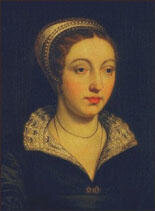
Kat Ashley
9. “Kat” Astley (sometimes written as Ashley) (born Katherine Champernowne) (c. 1502-1565)
Summary: A much-loved governess to the future Elizabeth I who went on to serve the queen as one of her highest-ranking and most powerful ladies.
-Kat was appointed a waiting gentlewoman to the 4-year-old Princess Elizabeth (the future Elizabeth I) in 1536, shortly after Anne Boleyn’s death, and became her governess in 1537. We do not know about Kat’s educational background, but it must have been impressive, as she taught the young princess a variety of subjects. Numerous secondary sources state that Kat taught Elizabeth “astronomy, geography, history, mathematics, French, Flemish, Italian, and Spanish,” in addition to the usual noble women’s education of needlework, embroidery, dancing, riding, and deportment. I actually haven’t been able to find more primary sources or encyclopedia sources that state that, but lots of blogs! In any case, contemporary records at the time indicate that those who met Elizabeth as a child found her extremely intelligent and “formidably learned,” indicating that Kat was indeed quite good at her job.
- Kat married Sir John Astley/Ashley, a senior gentleman attendant of Elizabeth’s in 1545. Apparently her new husband was also a distant relation of Elizabeth through her mother Anne Boleyn. As she was over 40 at the time, she was past childbearing age, so this marriage was likely for love.
-After Henry VIII died in 1547 and Edward VI took the throne, the teenage Elizabeth was sent to live with her stepmother Catherine Parr and her new husband Thomas Seymour. Kat accompanied her charge there. There, she witnessed Seymour’s flirtatious behavior toward the 14-year-old princess, which was at the very least inappropriate and may have actually constituted sexual abuse. Kat later described the flirting as “possibly questionable dealings.” Reportedly, on several occasions, Seymour, clad only in a nightshirt, “would come many mornyngs into the said Lady Elizabeth’s chamber, before she were redy, and sometyme before she did rise.—-And if she were in hir bed, he wold put open the curteyns, and bid hir good morrow…and one morning he strave to have kissed her in bed.” (Burghley’s state papers, vol. I., by Haynes, p 96, from the confession of Thomas Parrye her cofferer [treasurer], relating what Catharine Ashley told him)/ Seymour also supposedly cut Elizabeth’s black gown into ribbons while Kateryn Parr held her. Eventually, Parr found Elizabeth in Seymour’s arms and sent Elizabeth away.
- When Thomas Seymour was investigated for treason in early 1549, Kat was arrested and imprisoned in the Tower of London, along with her husband John and Elizabeths’ cofferer [treasurer]. There, she was interrogated on everything she knew about Seymour’s doings with Elizabeth. She was eventually released in March 1549 and returned to live with Elizabeth at Hatfield.
- Under the reign of Mary I, only a few years after Elizabeth herself was released from the tower, Kat was arrested and sent to Fleet Prison for owning seditious books. She was imprisoned for three months and afterward, was forbidden from seeing Elizabeth.
-Once Elizabeth rose to the throne, Kat served her as Chief Gentlewoman of the Bedchamber, wielding great power and influence at court.
-Kat died in July 1565 after a brief illness, after serving Elizabeth for almost 30 years. Elizabeth was incredibly fond of her and supposedly said “Anne Boleyn gave me life but Kat Ashley gave me love.”
MAZZOLA, ELIZABETH. “Schooling Shrews and Grooming Queens in the Tudor Classroom.” Critical Survey, vol. 22, no. 1, 2010, pp. 1–25. JSTOR, www.jstor.org/stable/41556342. Accessed 21 Oct. 2020.
The Progresses and Public Processions of Queen Elizabeth: Among which are Interspersed Other Solemnities, Public Expenditures, and Remarkable Events During the Reign of that Illustrious Princess, Volume 1
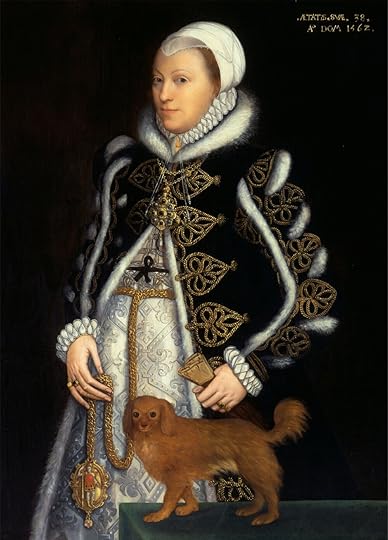
Lady Catherine Carey
8. Lady Catherine Carey (known after her marriage as Catherine Knollys) (c. 1524-1569)
Summary: A cousin of Elizabeth I who might have been her half-sister as well, Catherine served two Tudor queens consort and a queen regnant, endured religious exile, and had a prosperous family life, with over a dozen children surviving infancy.
- Catherine was the daughter of William Carey, Gentleman of the Privy Chamber and Esquire of the Body to Henry VIII, and Mary Boleyn, and thus, a cousin of Elizabeth I’s. Some believe that Catherine was an illegitimate child of Henry VIII, but there is no definitive evidence to prove such a theory.
- Catherine likely witnessed the execution of her aunt Anne Boleyn in 1536, at the age of around 12. She served both Anna of Cleves and Catherine Howard as a maid of honor.
- In 1540, she married Sir Francis Knollys, an English courtier and member of parliament who was favored by Henry VIII and had been in attendance on Anna of Cleves when she arrived in England. During Mary I’s reign, Catherine and her husband, who were staunch Protestants, fled to Germany.
- Catherine, a favorite of Elizabeth’s, was made Elizabeth I’s Chief Lady of the Bedchamber upon her cousin’s accession to the throne. While holding this high profile position, she gave birth to more than half a dozen children (she had 14 overall. All survived infancy except one). Her husband was appointed treasurer of the queen’s chamber in 1566 and promoted to treasurer of the household in 1570.
- Catherine’s husband Francis had the dubious honor of serving as the keeper of Mary, Queen of Scots, from 1568 to 1569. Catherine died in January 1569 while he was away dealing with Mary; Mary herself blamed Elizabeth for Catherine’s death, saying that Francis’s enforced absence was the cause.
-After Catherine’s death, her husband Francis would serve Elizabeth as a treasurer, advisor, and MP. He spoke out in support of the Puritans in particular. He eventually died in 1596.
- Of note: Catherine’s daughter Lettice would eventually marry the queen’s favorite, Robert Dudley, Earl of Leicester, without the Queen’s knowledge or approval. Although Lettice was the daughter of Elizabeth’s cousin and a former maid of her privy chamber, the furious Elizabeth banished her from court for the rest of her life.
-Catherine Carey was the 11th great-grandmother of Elizabeth II, the current queen of the United Kingdom.
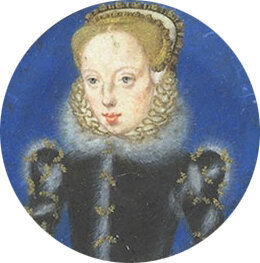
Lady Katherine Grey
7. Lady Katherine Grey (later Katherine Seymour, Countess of Hertford) (1540-1568)
Summary: A romantic who was too close to the throne, Katherine was punished for her secret marriage and imprisoned for the rest of her life.
-Katherine was a granddaughter of Henry VIII’s sister Mary and Jane Grey’s younger sister. According to the usual laws of succession, Katherine and her sisters were preceded in the line of succession only by Henry VIII’s three children and the descendants of Princess Margaret (Henry VIII’s elder sister who married the king of Scotland). However, Henry VIII had excluded the Scottish regnal line from the succession in his will, which placed Katherine even closer to the throne.
- In the final months of Edward VI’s life, Katherine and her older sister Jane were married on the same occasion to the relatives of powerful noblemen who wished to keep Princess Mary (Henry VIII’s eldest daughter and a notorious Catholic) from the throne (in accordance with Edward VI’s own wishes). Jane was married to Guildford Dudley, the son of Edward VI’s chief minister John Dudley, Duke of Northumberland, while Katherine was married to Henry, Lord Herbert, the heir apparent to William Herbert, Earl of Pembroke. After the wedding, Katherine went to live with her husband. After the failed attempt to put Jane on the throne, Henry’s father separated his son from Katherine and had their marriage annulled on the grounds of non-consummation. Katherine’s sister Jane and her father the Duke of Suffolk were both executed following Wyatt’s rebellion.
-Katherine was a maid of the privy chamber under Mary I but was demoted to a maid of the presence chamber under Elizabeth (all the higher gentry had access to the presence chamber). This indicated that Katherine was not in the queen’s favor, even though she was the presumptive heir to the throne at the time.
-As Elizabeth’s presumptive heir, Katherine’s marriage was the subject of much discussion among Elizabeth’s councillors and of others at court, including the Spanish ambassadors.
- In December 1560, Katherine secretly married Edward Seymour, Earl of Hertford, with only a priest and one witness (Edward’s sister, Jane) present. Jane died a few months later. This was against the law, as [anyone close to the throne had to have royal permission to marry]. Fun fact: Edward Seymour (who was the son of the more famous Edward Seymour, Duke of Somerset, who was executed under Edward VI) had a distant claim of his own to the throne, as he was descended from Edward III.
- While Edward was abroad in Europe, Katherine realized she was pregnant. This was…incredibly dangerous for a noblewoman and heir to the throne whom everyone believed to be single. Late in her pregnancy, she confessed her secret marriage and pregnancy to Robert Dudley, the Queen’s favorite, and begged him to intercede with her to the queen. Whatever Dudley said, it didn’t help, as Katherine was promptly thrown into the Tower of London. Her husband was also imprisoned shortly thereafter.
- While in prison, Katherine gave birth to a son, Edward Seymour, Viscount Beauchamp in September 1561. Shortly thereafter, a church commission declared Katherine’s marriage invalid. As the priest could not be found and their only witness had died, they had no evidence otherwise.
- Sympathetic guards in the tower had allowed Katherine and Edward to spend time together, which resulted in Katherine giving birth to a second boy in February 1563. The furious Queen Elizabeth had the lieutenant of the tower locked up in his own prison and had Katherine and her huband sent to different country houses, where there could be no more secret liaisons.
- Throughout Katherine’s imprisonment, her supporters worked both in court and in Parliament to have her sons recognized as legitimate, the couple freed from prison, and Katherine recognized as heir to the throne. In fact, a member of parliament named John Hales actually published a 1563 book which discussed Katherine’s right to the throne under Henry VIII’s will and pointed to protestant clerics who had ruled that Katherine’s marriage was valid under church law. Hales was later sent to the tower by Elizabeth. In 1566, numerous members of parliament who supported Katherine fought for the right to debate the succession, despite the queen’s direct command not to do so.
- Despite all efforts to help her, Katherine spent the rest of her life in prison, where she fell further into despair at being separated from her family. When she died in January 1568, at age 28, she had been separated from her husband and eldest son for over four years. Her husband Edward was later freed in 1571 and lived to the ripe old age of 84; in his final years, he had found the priest who had married them, definitively proving the validity of their marriage.
- Despite the sad end to her own life, Katherine is the 10th great grandmother of Elizabeth II, the current queen of the United Kingdom.
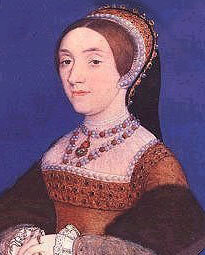
6. Queen Katheryn Howard (c. 1523-1542)
Summary: Katheryn Howard was a vivacious but neglected teenager who was involved with and abused by men from an early age, became Henry VIII’s fifth wife, and was executed tragically young.
- Katheryn was a member of the illustrious aristocratic Howard family and Anne Boleyn’s first cousin. Her immediate family however, was not wealthy and her father often had to beg for handouts from his rich relatives. Her mother had five children with her first husband and then had another six with Katheryn ’s father; as one of the youngest children, Katheryn was likely not her parents’ top priority.
- After her mother’s death when Katheryn was about 5 years old, she was sent, along with several of her siblings, to live with her father’s stepmother, the Dowager Duchess of Norfolk. Although it was common for noble families to send their children to be trained in other noble households, the Dowager Duchess’s household was notoriously lax and undisciplined. It is reported that the children there ran a little wild; several of the older girls there entertained male visitors in the girls’ dormitory at night, receiving gifts in return.
- Katheryn could read and write but was not as well educated as many of Henry’s other wives. She was apparently quite vivacious and giggly. At age 13, her adult music teacher Henry Mannox molested her repeatedly. Katheryn later reported, “At the flattering and fair persuasions of Mannox, being but a young girl, I suffered him at sundry times to handle and touch the secret parts of my body, which neither became me with honesty to permit nor him to require.”
At 15, she allegedly took Francis Dereham (who was at least 28), one of the Duchess’s secretaries, as her lover. They referred to each other as husband and wife and Katheryn kept track of Dereham’s money for him while he was away on business. This relationship was apparently common knowledge among many of the Duchess’s maids of honor and attendants. However, the Dowager Duchess of Norfolk put a stop to it when she discovered it.
Basically, the evidence indicates that Katheryn Howard probably was sexually active before her marriage, but as a very young girl with really no one looking out for her, it’s very likely that such activities weren’t entirely consensual. By modern standards, these relationships would definitely be considered statutory rape.
- Later, her uncle, the influential Duke of Norfolk, Thomas Howard, obtained a place for her in Anne of Cleves’ household, where she served as a maid of honor. Henry met her there and became a bit infatuated, claiming he had never known her “like to any woman” and giving her great gifts of land and expensive cloth. He called her his “very jewel of womanhood” (the story that he called her “his rose without a thorn” is a myth). Contemporary accounts describe Katheryn as giggly and vivacious. She enjoyed dancing but was often distracted and jocular during her lessons.
- Katheryn married Henry when she was possibly around 17 and he was 49, less than a month after his marriage to Anna of Cleves was annulled. She was Queen from July 1540-November 1541.
- After her marriage to Henry, Katheryn supposedly became romantically involved with one of Henry’s favorite courtiers Thomas Culpeper, who called her “my little sweet fool” in his letters. Katheryn’s lady-in-waiting Jane Boleyn, Lady Rochford (George Boleyn’s widow), reportedly assisted with their secret meetings throughout a royal progress.
However, although I always thought that Katheryn Howard’s adultery with Thomas Culpeper was pretty well supported by evidence (i mean, it’s certainly more supported than the allegations against Anne Boleyn), but when I researched into it more, the case is a lot more nebulous than I realized. Her relationship with Thomas Culpeper was supported by a “love letter” from her found in his chambers; however, the phrasing in the “love letter” was actually pretty standard for letters between friends in that time, so it’s definitely possible that their relationship wasn’t a torrid love affair at all. I’m sorry, Katheryn, for everything wrong I’ve said about you before.
- At the same time, people who knew of her previous “relationships” with Dereham and Mannox began to blackmail her for her silence about her relationships pre-marriage; she may have appointed some of these to her royal household.
- Nasty gossip and rumors really brought about Katheryn’s downfall. Allegedly, a fairly random man named John Lascelles tried to talk his sister Mary into working for the Queen, but she refused, saying she knew of Katheryn’s sexual activities when they both lived together in the Duchess’s household and that she wouldn’t be willing to work for her after that. Lascelles reported this to the Archbishop of Canterbury Thomas Cranmer, who then launched a quiet investigation into Katheryn’s background. During that time, he spoke to Mary Lascelles and Lady Rochford. This investigation turned up the supposed love letter from the Queen in Culpeper’s chambers (which again, by the standards of friendship of the time, may have actually been just a friendly letter). Henry was probably unaware of the entire situation until he received a warrant of her arrest. Thomas Cranmer was apparently deputized to tell Henry about the Katheryn situation, as everyone else was too scared to do so, and Henry liked Cranmer best (see: why I ranked him #1 in the “My Favorite Thomases” post). (Note: Cranmer may have had additional political motivations to topple the Howards, fyi).
- Soon thereafter, Katheryn was questioned by a delegation of councillors. Cranmer later said, “I found her in such lamentation and heaviness as I never saw no creature, so that it would have pitied any man's heart to have looked upon her." She was stripped of her title as queen on November 23 1541 and imprisoned in Syon Abbey (which her ghost supposedly haunts to this day) throughout the winter of 1541. Henry refused to see her again. (Interestingly enough, their marriage was never formally annulled). Throughout her imprisonment, Katheryn refused to admit that there was a precontract between her and Francis Dereham, even though that precontract would have terminated her marriage to Henry and possibly saved her life.
- Several of Katheryn’s relatives were also imprisoned in the tower during this debacle, although the Duke of Norfolk managed to escape this fate by groveling to the king and blaming his niece and stepmother in a letter. The Howard prisoners were found guilty of concealing treason and sentenced to life imprisonment and forfeiture of goods
- In December 1541, Culpeper and Dereham were both executed publicly at Tyburn for high treason; the noble Culpeper by beheading and the commoner Dereham by being hanged, drawn, and quartered.
- In February 1542, Katheryn was attainted for treason by Parliament, on the basis of the Royal Assent by Commission Act of 1541. This act stated that a queen consort who failed to disclose her sexual history to the king within twenty days of their marriage or who incited someone to commit adultery with her had committed treason. [SIDENOTE: The fact that they needed to pass this act seems to indicate to me that they did NOT have very strong proof that Katheryn actually committed adultery, and wanted an excuse to get her out of the way]. When the Lords of the Council came to fetch Katheryn and put her on a barge to the Tower of London, poor Katheryn apparently panicked an screamed.
- Katheryn asked for the execution block to be brought to her chamber the night before her execution, where she may have spent time practicing how to lay her head upon the block. At her execution, she apparently was very pale and needed help to climb the scaffold. Although there’s a legend that she said something along the lines of “I die a Queen but I would rather have died the wife of Culpeper,” contemporary accounts indicate that she stuck to the traditional final words asking for forgiveness and praising the king. (Remember, the king could do anything to someone’s family after they were executed). Her lady in waiting, Lady Rochford, was executed immediately thereafter on Tower Green. They were buried in an unmarked grave in the nearby chapel of St. Peter ad Vincula.
October 13, 2020
Over-Analyzing Six the Musical: Haus of Holbein

Hans Holbein’s self-portrait, c. 1542-1543.
All My Six Posts!
Over-Analyzing All the Historical References in Six- “Ex Wives,” “No Way,” “Don’t Lose Your Head,” “Heart of Stone”
Virtual Dance Workshops and Q&As with Different Six Cast Members!
(^This post includes links to workshop/q&a roundups from Grace Mouat, Natalie Pilkington, Sam Pauly, Cherelle Jay, Vicki Manser, Collette Guitart, Jen Caldwell, and Harriet Watson)
Details from Six Costumer Gabriella Slade’s Instagram Takeover
Six the Musical Wives 1-3: Historical and Modern Costume Inspirations
Six the Musical Wives 4-6: Historical and Modern Costume Inspirations
The Early Costumes of Six the Musical: From Edinburgh to Cambridge to London
Updated Six the Musical Costumes for Broadway!
The Alternate Costumes of Six the Musical
The Shoes of Six the Musical
The Ladies in Waiting of Six: Historical Inspirations and Costumes
The Tudor Fashion Elements of the Costumes in Six (with Painting References)
How the Six Alternates Change Their Styling for Each Queen
I’ve been meaning for a while now to write out analyses of all the songs in Six, looking at all the historical and pop culture references in them, but i’ve had a lot of trouble finding the focus and motivation to do so during all this self isolation. I started this series in like….April? But here we finally are. Hope you enjoy it. I plan on putting up one for each song eventually, but I’m working on other blog projects as well, so it may take a while.
Today, we’re looking at arguably the strangest song in the musical - Haus of Holbein.
Dialogue and lyrics in the show are in bolded font and my commentary is in italics. :) A lot of times, it’s really not relevant who said what line of dialogue, but I’ve inserted the queen’s name if it is.
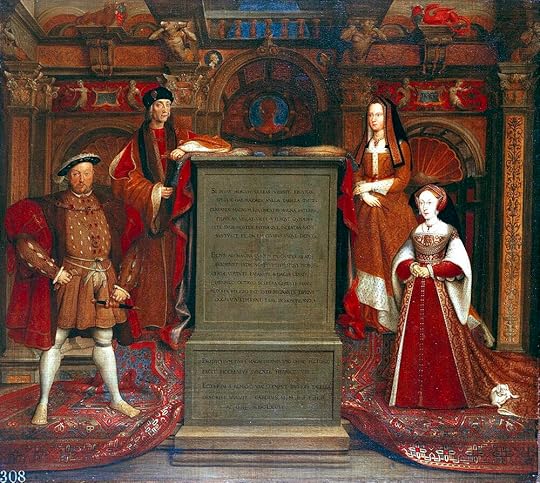
Copy of a lost painting by Holbein showing Henry VII, Elizabeth of York (Henry VIII’s parents), Henry VIII, and Jane Seymour)
Cleves: Now, seeing as Henry was running out of women to marry in England, he had to look a little further afield. He had to adjust his location settings, if you will.
This lead-in is obviously a joking reference to the number of Henry VIII’s wives, but it actually really wasn’t standard practice for English princes/kings to marry English women. It was more common for royals to marry off their sons to princesses or noblewomen from abroad to secure alliances. Before Henry VIII changed things up, the only previous English female royal consorts were Elizabeth Woodville (wife of Edward IV. Their marriage and the favors shown to her family ended up being incredibly divisive and basically re-started the Wars of the Roses), Anne Neville (whose husband Richard III was never expected to become king), and Elizabeth of York (whose marriage to Henry VII, Henry VIII’s father, was entirely strategic to end the English civil wars known as the Wars of the Roses). Over his life, Henry VIII would marry two foreign noblewomen in the traditional manner (Catherine of Aragon and Anna of Cleves) and four Englishwomen (Anne Boleyn, Jane Seymour, Katherine Howard, and Kateryn Parr).
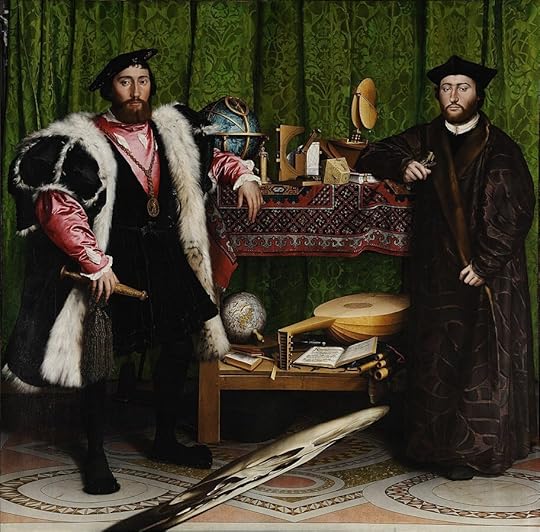
Double portrait of Jean de Dinteville and Georges de Selves (“The Ambassadors,” 1533), by Hans Holbein the Younger
“Location settings” refers to the dating app Tinder, which will pop up again later in this song as well.
To find his next queen, we’re heading to Germany. Where he enlisted the help of the legendary painter, Hans Holbein. Welcome to the house…To the Haus of Holbein, ja!
Ja-yes in German.
This song is a tribute to and pun on German electronic music, as it’s literally written in the form of house music (house/haus - get it? Haus in German LITERALLY means house.). House music is a genre of electronic music which is easily recognizable by a repetitive, insistent beat and a fast tempo. German electronic music in particular has been really influential on the entire genre of house, as it was an active underground subculture before the fall of the Berlin Wall that simply exploded after Germany was reunified. I really can’t say much more about house music or German electronic music, as it’s completely not my area of expertise and I’m terrified of saying something wrong and having music fans come after me, but the association of Germany with electronic music is well known enough that the moment I heard this song, I just started laughing. I personally think it’s the most on point musical pun in the entire show.
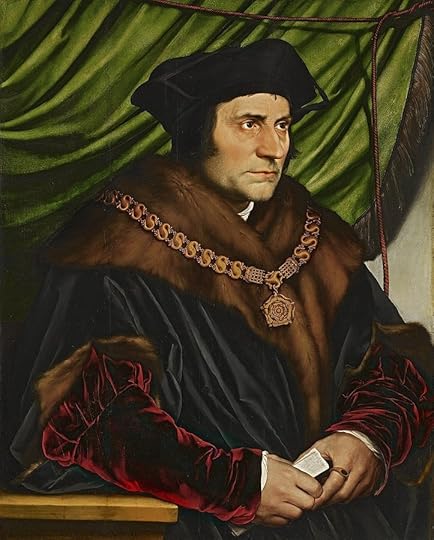
Portrait of Thomas More (1527), by Hans Holbein the Younger
Hans Holbein the younger was a German painter who’s now one of the most famous Renaissance painters who worked in England, rather than Italy (like all those guys named after Teenage Mutant Ninja Turtles). He first started his work in England as an acquaintance of Thomas More, and later came back under the patronage of Anne Boleyn and Thomas Cromwell. He became King’s Painter to Henry VIII by 1535, but funnily enough, he was actually the junior painter at the time; he was never the highest-paid artist on the royal payroll.
Today, his portraits of various English figures are by far the most famous and well-known from Henry VIII’s time. I’ve included lots of his paintings throughout this post.
Additional references from the phrase “Haus of Holbein”:
In renaissance times, it was really common to refer to a noble family as a house. Think, House of Lancaster, House of York, House of Hapsburg, etc. This is a fun reference to this and appropriates the word to refer to Holbein, who wasn’t noble and was from a common family.
It’s pretty common to say that an unknown artist who’s clearly painting in the style of a specific artist and was possibly taught by them is from that artist’s workshop, or is a follower of them. You’ll see attributions along the lines of “after Holbein,” “Holbein’s workshop,” or “follower of Holbein.” Although I haven’t seen “house of” used in this specific way, the entire “house of holbein” concept may possibly refer to this.
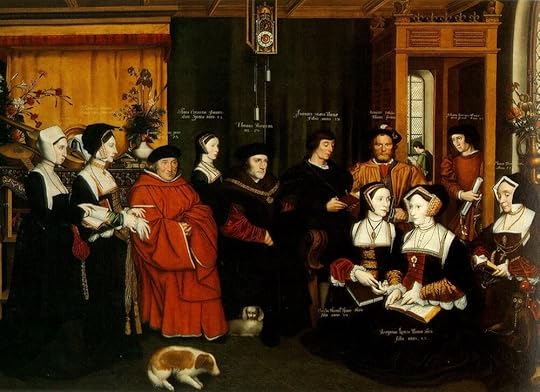
copy of a lost painting of Thomas More’s family (1592), by Hans Holbein t
Hans Holbein goes around the world Painting all of the beautiful girls.
From Spain, To France, And Germany.
The king chooses one, But which one will it be?
We know for a fact that Hans Holbein painted Anna of Cleves and her sister Amalia (both in Germany), Louise of Guise, and Anna of Lorraine (both in France), and Christina of Denmark. I couldn’t actually find any portraits of anyone from Spain, but if anyone knows of any, please let me know!
Germany was at the time divided into various states and duchies. English speakers began to refer to the region as Germany in about 1520 and the group of languages as “Germanic.” The name was derived from the Roman term “Germania,” which simply described fertile lands beyond a specific Roman border known as the Limes; Romans also referred to the tribes there as “Germani,” but the tribes themselves did not use the term. Germans refer to themselves as “Deutsche” (which roughly translates to “people” or “nation”) and their country as “Deutschland.” Germany wouldn’t actually exist as a unified country until 1871. (Fun fact: before English speakers referred to the land and people as Germany and Germans, they referred to the area as Almany and Almains, which derives from old French. These terms were obsolete by the 19th century).
You bring the corsets. We’ll bring the cinches. No one wants a waist over Nine inches.
So the undergarments they’re referring to here weren’t actually known as corsets at the time, but stays . This line is obviously used for humor and overexaggeration, but it also illustrates a common modern belief that women in the past were just smaller due to . This isn’t true. There were plenty of “plus size” women in the past.
Also tight-lacing wasn’t a thing then. As this article from Collectors Weekly notes, “Even though so-called “tight-lacing” was popular during the late 1800s, women rarely reduced their waists more than 1-2 inches. Generally, a corset with a 20-inch waist would be worn with a gap in the back, so the woman’s corseted waist measured between 22 and 26 inches. Where did these tales of ladies of the court and their obscenely tiny 13-inch waists come from? Fetish fantasy literature of the era.” If you’d like to learn more about historical corsets and the myths that popular media have spread about them, please watch all the YouTube videos of Karolina Żebrowska and Bernadette Banner (historical fashion YouTube is SO WONDERFUL, Y’ALL).
The term cinches refers to the fact that a corset literally “cinches” in your waist.
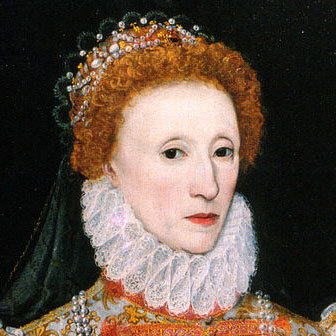
A close up of a portrait of Elizabeth I, unknown artist, c. 1575. Elizabeth I was known for wearing white makeup containing lead to cover her smallpox scars.
So what, The makeup contains lead poison? At least your complexion will bring all the boys in.
Yes, Renaissance makeup actually did contain lead. As the National Geographic noted in one article , “Women in the Roman Empire used lead makeup to whiten their faces , and in the 16th century, English nobles did pretty much the same thing. One of the most famous figures to use lead makeup was Queen Elizabeth I, who used it to cover her smallpox scars . This mixture of lead and vinegar that Elizabeth used was known as Venetian ceruse, or the spirits of Saturn. While it may have smoothed a woman’s complexion day-to-day, over time it caused skin discoloring, hair loss, and rotted teeth .”
Ignore the fear and you’ll be fine, We’ll turn this vier into a nine.
So just say “ja” and don’t say “nein”... ‘Cause now you’re in the house,
In the Haus of Holbein, ja! Ooh ja! Das ist gut, ooh ja! Ja! The Haus of Holbein.
Vier in german means four. Ja – yes; nein – No.
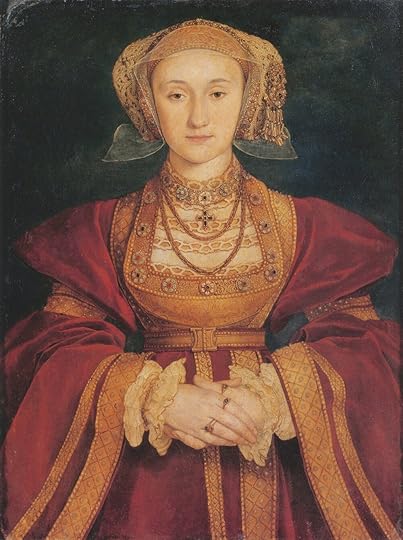
Anna of Cleves, by Hans Holbein the Younger, c. 1539
We must make sure the princesses look great
When their time comes for their Holbein portrait!
Anna and Amalia of Cleves weren’t actually princesses, they were the daughters of a duke, so they were duchesses. (Sidenote, go read my friend Heather Darsie’s book “ Anna, Duchess of Cleves: The King’s ‘Beloved Sister ’”). They are often referred to as princesses but that’s not quite accurate. They were the daughters of the ruler of the Duchy of Cleves, which was a state of the Holy Roman Empire. The HRE was a decentralized, limited elective monarchy, and the emperor really didn’t have a lot of power, so the Duke was effectively the highest authority in Cleves. I understand why people think the daughters of the highest authority in a land are princesses, but…no.
Christina of Denmark, whose portrait Holbein also painted, was a Danish princess, the youngest surviving daughter of King Christian II of Denmark and Norway and Isabella of Austria.
We know what all the best inventions are
To hold everything out. Ja, it’s wunderbar!
This is a terrible pun on the Wonderbra . Wunderbar in german literally means wonderful.
For blonder hair, then you just add a magical ingredient from your bladder.
Urine was really used to bleach hair blonde back in ancient times, but I couldn’t find reliable evidence of it being used in the renaissance. It’s possible that it was? I found SO MANY random blog posts on this and other methods that renaissance women used to bleach their hair, but couldn’t find a reliable historical periodical or a primary source reporting on it. Other reported methods of bleaching the hair in Renaissance Italy were use of natural ingredients such as alum, oak apples, walnut shells and bark, sulfur, and lemons, and exposure to the sun.
Try these heels, so high it’s naughty. But we cannot guarantee that you’ll still walk at forty.
High heels weren’t really a thing under Henry VIII. You got a bit of a low heel under Elizabeth I, but you didn’t really get stratospherically high heels in England until the late 1600s under the Stuarts. And then, it started first as a men’s fashion.
Ignore the fear and you’ll be fine, We’ll turn this vier into a nine.
So just say “ja” and don’t say “nein”... ‘Cause now you’re in the house…
In the Haus of Holbein, ja! Ooh ja! Das ist gut, ooh ja! Ja! The Haus of Holbein.
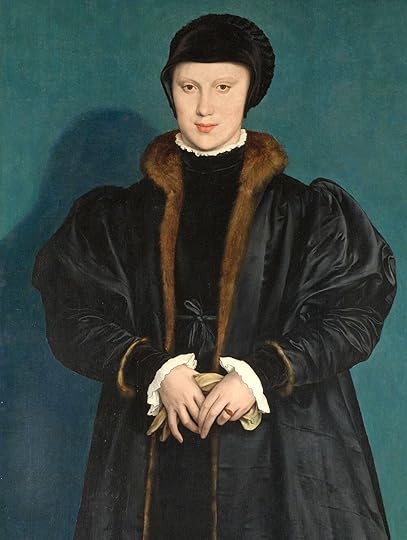
Christina of Denmark, by Hans Holbein the Younger
The time has come for you to select your bride, your highness! May we present Christina of Denmark? One of the queens goes up on stage to represent Christina. She’s in front of three boxes, and stands in the middle one. Looking for mates, dates, and a British monarch whom to secure the line of succession, winky-face. “Christina” steps over to the right box, where the box lights up red and a sound effect of a thumbs down is played.
Nein? Well, never mind, she already made a match with the Duke of Milan. Okay, next! “Christina” steps down.
This entire segment is based on Tinder, which I’ve never personally used (met my future husband before it became popular), but apparently you swipe one way on a person’s profile if you’re interested and swipe another way if you’re not interested. If you both swipe that you’re “interested,” you get a match and can start talking. It’s interesting that they use this here in the show, but of course the women don’t get to swipe either way, because they really didn’t have any choice in the matter.
Christina of Denmark WAS one of the women painted by Hans Holbein, but apparently she didn’t really want to marry him. She supposedly joked that she would marry Henry VIII if she had two heads. It was said that her aunt, Dowager Queen Mary of Hungary, the Governor of the Low Countries, who served as Christina’s guardian, was also very much unenthused by the match.
She really did go on to marry the Duke of Milan, then after his death, the Duke of Lorraine. She served as regent of Lorraine during her son’s minority until the king of France captured him and took him to be brought up at the French court. She went into exile and later briefly attempted to claim the throne of Denmark.
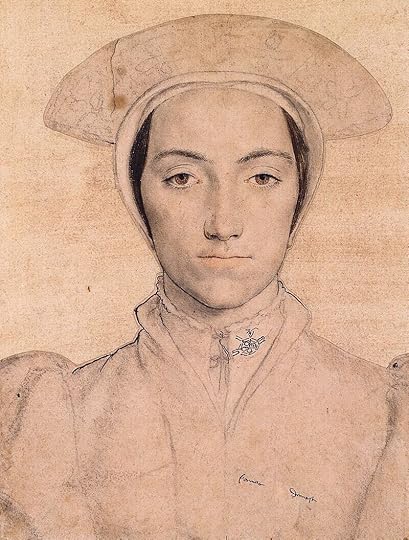
An unidentified woman, previously identified as Amalia of Cleves, by Hans Holbein the Younger, c. 1539
Your highness, may we present Amalia of Cleves? Another queen steps up to represent Amalia of Cleves. It is the same setup. Just a German girl trying to live the English dream. Hashtag no Catholics, hashtag big dowry. “Amalia” steps over to the right box, where the box lights up red and a sound effect of a thumbs down is played yet again.
Amalia was two years younger than Anna and remained in Cleves for her entire life, never marrying or having children. So the religion of the ruling family of Cleves is commonly misunderstood. They’re commonly described as Protestant (which is referred to several times in Six) but the truth is a bit more complicated than that.
Anna and Amalia’s mother Maria von Berg was a very devout Catholic woman; their father Johann III von Jülich-Kleve-Berg (sometimes known as John III the Peaceful) was tolerant of religious differences and created church regulations with the help of Catholic humanist Erasmus. So it’s likely that the sisters both grew up Catholic. Their eldest sister Sybille was married off to John Frederick of Saxony, who went on to lead the Protestant Schmalkaldic League. Their brother Wilhelm’s religion is a little amorphous, as his four daughters received a Lutheran education, but his two sons received a Catholic education .
Anna received a Catholic funeral in England , as she had requested in her will, and was likely Catholic herself. In contrast, Amalia was so fiercely dedicated to Lutheranism that she apparently annoyed her brother enough to have her go after her with a sword at one point (a servant stopped him, never fear). She refused to go to the Catholic funeral ceremony of WIlhelm’s wife, her sister-in-law. Wilhelm got his revenge eventually by having her interred at a Catholic church in Düsseldorf.
The “Big Dowry” reference is a little odd, as Anna of Cleves actually did not have a dowry , so presumably her sister Amalia wouldn’t have had one either.
Can we DISCUSS how gorgeous Amalia’s eyes and eyebrows are in this painting? As a brown-eyed girl myself, I deeply appreciate this.
Nein? Okay! Who’s next? “Amalia” steps down. The queens discuss amongst themselves quickly. Then Anna of Cleves steps up. Anna! Fantastic! Wunderbar! Your highness, your highness, your highness! We are honoured to present to you Anna of Cleves! The most beautiful woman in all of the Holy Roman Empire! And let me assure you, Herr Holbein has certainly done her justice. This time, the box to the left of Anna lights up green and a thumbs up sound effect is played.
Ah, the good! And may I say you will definitely not be disappointed? Oh, no need to thank us, the pleasure has been ours—In the Haus of Holbein! The Haus of Holbein.
I’ve talked about the “Anne of Cleves didn’t look like her portrait” story before and will talk about it more in depth in the blog post on “Get Down,” but in brief, 1. Holbein was specifically instructed not to flatter the women he was painted, but only to paint what he actually saw, and 2. Holbein kept his job and worked for Henry for years after his marriage to Anna was annulled. So that indicates that the portrait actually really was a good likeness of her. We’ll get into that more later though. :)
October 2, 2020
Cosplaying as Elizabeth Woodville for TudorCon!
Other English History Content:
Tudor Watch Party 1: The Other Boleyn Girl
Tudor Watch Party 2: Mary of Scotland (coming soon!)
My Favorite Thomases: A Review of and Often Arbitrary Ranking of Tudor Thomases
Henry VIII’s Jousting Accident Probably Didn’t Change his Personality
How Accurate were Shakespeare’s Histories?
My Obsessive Shakespeare English History Play Family Tree
Overanalyzing The Crown Season 3 (link to all posts)
The Medals, Sashes, and Tiaras of The Crown
Diadems, Tiaras, and Crowns, Oh My!
Disney Crowns and Tiaras: Historical and Modern Inspirations
The Historical Inspirations in Game of Thrones
Six the Musical Wives 1-3: Historical and Modern Costume Inspirations (which includes links to ALL my Six posts)
Six the Musical Wives 4-6: Historical and Modern Costume Inspirations
The Ladies in Waiting of Six: Historical Inspirations and Costumes
The Tudor Fashion Elements of the Costumes in Six (with Painting References)
Well, I may not be the most beautiful woman in medieval England, but I think I turned out alright!
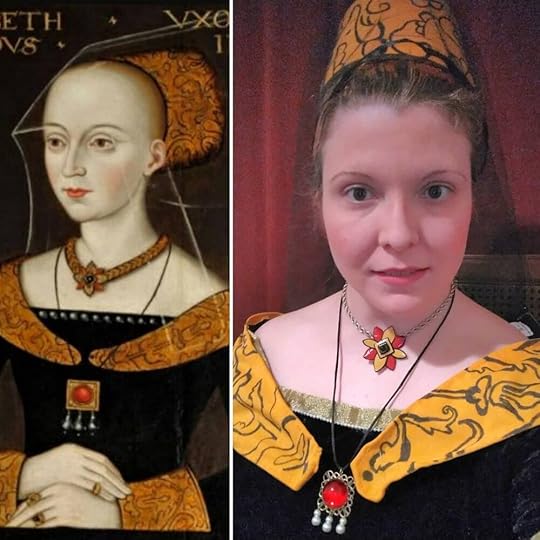
I put together this Elizabeth Woodville cosplay for my TudorCon talk, which is all about the effects of the wars of the roses on Tudor policy. I've actually never put together a historical costume before and this is the most work I've ever put into any costume (my costumes tend to be put together by combining various purchased pieces; I usually don’t actually make any of the pieces!).
It's been thrown together with less than expert skill and frankly would only work for zoom, as lots of things are pinned into place. It all looks a lot worse from the back, but decent from the front, yes?
The base dress is a black Tudor style dress from ArtemisiaDesignsCo on Etsy which is also serving as my Anne Boleyn costume base (for Sunday, when I'm reading questions for Tudor trivia - I’ll post pictures of that later!). I hot glued some pearl beading around the square collar but otherwise haven't altered it; I just unzipped it a little and pulled it down my shoulders to get the Elizabeth Woodville dress collar look. The collar fabric is just pinned into place so I can easily take it off and make it Tudor style again.
I got the yellow fabric free from a friend. I pretty much freehanded the shape, hemmed it, and used black fabric markers to imitate the pattern. The hennin was made from a basket + sewed on and hot glued cloth + fabric markers. The only way I've figured out how to keep it on my head is to first put on a Disney tiara, then position it on top of that.
The veil was actually a prop from a virtual production of Twelfth Night I was in a few months back (it's two tiered but I just turned it around and pinned it into place). I got a piece of thin white fabric that matched the portrait a bit more closely, but it ended up being too opaque to see any of the details on the hennin.
The longer necklace is from Treasuresforaqueen on Etsy. The shorter floral necklace is a pendant I commissioned from Aliciasoddities (she specializes in gorgeous metal flower pendants) hanging on a chain I already owned, which I've looped around and pulled tight (it's normally not a choker). #tudorcosplay #historicalcosplay
September 7, 2020
Tudor Watch Party 1: The Other Boleyn Girl
I’ve started doing a roughly weekly Tudor Watch Party. Here’s everything I wrote about the first selection for it, The Other Boleyn Girl.

This 2008 film starring Natalie Portman and Scarlet Johansson brought Philippa Gregory's novel to the big screen and was part of a revival of interest in Tudor stories at the time (as also indicated by the TV show The Tudors, which ran from 2007-2010).The Other Boleyn Girl tells the familiar story of Anne Boleyn and Henry VIII's "Great Matter" through the eyes of her sister Mary Boleyn, spinning historical rumor about Mary and Henry into a scandalous, sexy story.
The #1 New York Times bestselling novel the film is based on was the first book Philippa Gregory wrote about the Tudors/Plantagenets. Gregory has now written 15 of them, which have been turned into at least four separate TV series (a TV version of The Other Boleyn Girl, The White Queen [which actually combined three of her novels]), The White Princess, and The Spanish Princess [based off of The Constant Princess]).
Warning: A lot of this film is based on historical rumor instead of fact and a ton of it is fictionalized. But that should give us a ton to talk about!
The Other Boleyn Girl is up on Amazon Prime to rent for $2.99. I'll try to pick selections that are free to stream every other week so this doesn't get too expensive for anyone, promise!
Various notes from my watch of The Other Boleyn Girl:
So it’s actually been YEARS since I’ve watched this film. I would guess probably at least 6. I know much much more about Tudor history and Anne Boleyn in particular than I did upon watching it for the first time. This film and the book it is based upon is /not/ meant to be a historical documentary, so I won’t go into every little thing they get wrong, but I’ll try to talk through the big things I notice as I watch through.
The film portrays Anne as the eldest child, but historically, it’s a bit more iffy. We don’t even know the exact year Anne was born, and she was by far more well known than her sister. Most historians seem to believe that Mary was the eldest child, as she was indeed married first, and her descendants later acted as if she was the eldest by claiming their titles based on that ranking. In addition, when Anne was created a Marchioness in 1532, she was referred to as one of the daughters of Thomas Boleyn; if she was the eldest, that probably would have been explicitly stated.
The film portrays Anne as being present at Mary’s wedding to William Carey and being sent off to France as a punishment later, for her relationship with Henry Percy, and then only for a few months. In reality, Anne was sent to Europe at a much younger age, such treatment was an honor and not a punishment, and she wasn’t even in the country at the time of Mary’s wedding in 1520. Anne was actually sent off to Europe in 1513, where she served in the court of Margaret of Austria in the Netherlands. She was transferred to France in 1514 to attend Henry VIII’s sister Mary, who married Louis XII. Louis died only a few months into his new marriage, and then Anne moved to serve Queen Claude. She stayed in France until 1522.
Costuming Note: Anne is very often shown in shades of green, as a nod to the historical myth that Henry VIII wrote Greensleeves for her. This isn’t accurate at all, as we know that Greensleeves was based off of a romanesca, an Italian style of musical composition that did not reach England until after Henry VIII's death.
From what I can tell as someone who’s researched Tudor fashion a lot at this point but is admittedly still an amateur on the subject, the film is pretty accurate at least in the shapes and styles shown. Its characters are generally shown wearing some sort of head covering (as opposed to “The White Queen,” where no one ever wears a hat) and those head coverings look pretty realistic, as opposed to the much more fanciful headwear sometimes sported by Anne Boleyn in the TV show “The Tudors.”
Possible Costuming Quibble: Men are shown sporting very heavy, wide coats that make them look rather boxy. Henry VIII IS known for making this fashionable, but I was under the impression that this fashion developed later in his reign, when he had put on weight and was no longer the trim young handsome man. Don’t get me wrong, there were still a lot of layers and bulk, but I didn’t think men’s fashion had gotten /quite/ this wide yet.
Costuming Note: It’s accurate that some women would be wearing the gable hood (as seen in Queen Katherine’s court) and some would be wearing a French hood (as seen worn by Mary and Anne). The French hood was likely brought to the Tudor court by Mary Tudor around 1516 ish, but the gable hood remained pretty popular until the 1530s or so. The French hood did become very strongly associated with Anne Boleyn, but she by no mean originated the fashion in England.
We don’t really know how much Thomas Boleyn (Anne and Mary’s father) and Thomas Howard (their uncle) were involved in pushing Mary into the king’s arms, and later, Anne. This is a very commonly portrayed dynamic, but no one really knows. The film portrays her father and uncle asking Mary very bluntly about her sex life with the King (and in front of her husband, mother, and brother too), which like, ick and ick forever, but again, we really don’t know
Mary Boleyn also went to France in 1514 to serve Princess Mary as she married Louis XII of france. She stayed on in France and served Queen Claude along with her sister until 1519. She began serving Catherine of Aragon then, even before her marriage.
Although her affairs were likely exaggerated, the French king did refer to her as a very great whore and the English Mare, so Mary may have been involved with the king himself. We do know that she slept with Henry VIII though, as it was based on this relationship that Henry’s marriage to Anne was later annulled. When Henry was trying to get the pope to annul his marriage to Catherine, he also requested dispensation to marry Anne, the sister of his former mistress. In any case, the choice to portray Mary as super shy is an interesting one.
It was rumored at the time that at least one of Mary’s children was the King’s, but there’s no evidence supporting this. Henry did not acknowledge them as his, as he did Henry Fitzroy, but then, Mary DID have a husband (while Henry Fitzroy’s mother, Elizabeth Blount, did not).
It’s shown in the film that Mary found out about Anne’s marriage to Henry Percy, told her father and uncle about it, then they put a stop to it. Historically, Anne was only betrothed to Henry Percy, but this betrothal was broken off when Percy’s father refused to allow it. There’s no evidence that they actually had sex (as happened in this film). Cardinal Wolsey, who was basically running England for Henry VIII at this point, helped put a stop to the match as well, which likely earned him Anne’s enmity for the rest of her life.
Other Tudor Pop Culture Note: Interestingly enough, this film doesn’t portray Cardinal Wolsey at all. He's mentioned like, once, as a courtier says Wolsey will draw up plans to send Catherine of Aragon to a nunnery, but we never see him. That’s really weird, given how much of a role Wolsey played in Anne Boleyn’s life. He generally shows up in any pop culture set during Henry VIII’s early reign, including The Tudors and Shakespeare’s Henry VIII.
Lady Elizabeth Boleyn does appear in this film and plays a pretty big role. I’m pretty sure she never shows up in the Tudors, or if she does, it’s very tiny, as I’ve watched that TV show several times now and don’t remember her at all.
Back to History: The film portrays Thomas Boleyn being made an earl because of Mary’s becoming pregnant with her first child, but in reality, he wasn’t elevated to the peerage until 1525, when Henry VIII was pursuing Anne, and at the time, he was only made a Viscount. He was made an Earl in 1529 and George Boleyn was only then given the title of viscount. Mary’s first child, Catherine, was born in 1524. Her second child Henry was born in 1526.
The marriage of George Boleyn and Jane Parker is very commonly portrayed as an unhappy one, but there’s really no contemporary evidence supporting that. She was believed for a long time to have had a role in the downfall of her husband and Anne Boleyn, but again, there’s no indication that it was actually the case.
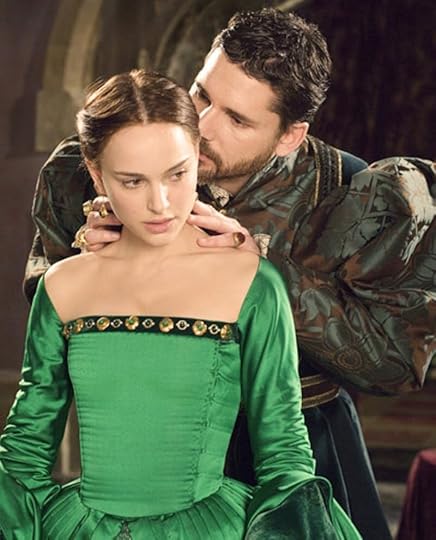
In the film, the plotting Thomases say that the king will no longer bed Mary now that she’s lying in, so they need Anne to come in to get his attention. First, they generally called the time before the baby was born confinement, rather than lying in. Second, many people in Tudor times believed that any sex during pregnancy could be dangerous for the baby, so in reality, Henry probably stopped “bedding” any of his wives or mistresses the moment they knew they were pregnant. The film also mentions that Henry visits Mary during her lying in, and shows George visiting her as well. During a queen's pregnancy, anyway, no men would be allowed into her rooms during the confinement. I'm not sure if the same rules would be applied to a royal mistress. The rooms were very dark though, as George observes in the film, as it was practice to draw all the curtains and block out the sun during a queen's confinement (I actually have no idea if this was the practice for other, non-queen noble women as well).
Anne talks about “the queen” she served in Europe providing her ladies a broad education and introducing her to scholars and philosophers. Henry refers to them as Lutherans and heretics. The plotting thomases refer to the queen as “the dowager queen.”
It seems that they’re conflating the French court of Queen Claude (a very catholic woman who was NOT a widow at the time and thus wouldn’t have been called a dowager) with the court of Margaret of Austria, in the Netherlands (remember, Anne Boleyn served them both). Claude was pregnant almost her entire marriage and had a strict moral code for everyone in her household.
Margaret, a widow, served as governor of the Habsburg Netherlands from 1507-1530. She had a famously large library, was patron to numerous artists and musicians and also had several humanists visit her court. Erasmus was a humanist and a progressive who believed the Roman Catholic church needed to be reformed, but he was also definitely a traditional Catholic who believed in transubstantiation, and disagreed quite openly with Martin Luther and other big name Protestants. She also was a patron of Heinrich Cornelius Agrippa, who was a theologian with some controversial ideas and interest in the occult, but also …was definitively Catholic, albeit one who criticized abuses of the catholic church and sympathized with Martin Luther. I really can’t pin down what the script is referencing here.
With more research…maybe they’re referring to Marguerite de Navarre? It’s possible that Anne served Marguerite rather than Claude, as their courts may have overlapped, but it’s not fully known. We do have a letter from Anne (post being made queen) where she said some very nice, affectionate things about Marguerite, so it’s possible. Marguerite was a princess of France and Queen of Navarre (whose husband in 1525, so...conceivably she could be referred to as a dowager queen). Marguerite was also a huge patron of the arts and DID indeed serve as a mediator between Roman Catholics and Protestants. She advocated for reforming the church but was not actually a reformer herself.
So okay, I think the film is referring to Marguerite de Navarre, just…in a very weird round about way, as I don’t think they ever refer to Navarre rather than France. Navarre is not in France, but is in Spain, although it is on the border, so if they're trying to refer to Marguerite, they're not doing it very accurately or clearly.
I am actually really enjoying how many British actors who later became known for other things show up in here. Benedict Cumberbatch plays Mary’s husband William Carey, who appears for maybe half an hour and then disappears. Eddie Redmayne plays Mary’s second husband, William Stafford, and pops in every once in a while. Alfie Allen (Theon in Game of Thrones) shows up just as a messenger trying to deliver a gift to Anne from the queen.
Wow, Anne really is a bitch to her sister in this film. The bit where she actually secures Henry’s promise to never bed his wife again and never speak to Mary again in exchange for her someday maybe being his lover, RIGHT after Mary has given birth, so Henry literally walks away from Mary and his son with her without talking to her at all? GOOD LORD. (to be fair, it was Henry’s idea, not hers)
Historical note: Mary’s first child was a daughter, not a son.
Is it weird that in this film about a quintessentially English story, the main three actors aren’t English? Natalie Portman is a citizen of both Israel and the US, Scarlet Johansson is American, and Eric Bana is Australian. I bet people were pretty pissed about that at the time. Most of the secondary actors are English though: Jim Sturgess (George Boleyn), Kristen Scott Thomas (Elizabeth Boleyn), Mark Rylance (Thomas Boleyn – and also, he famously played Thomas Cromwell in Wolf Hall), David Mark Morrissey (Thomas Howard), Benedict Cumberbatch (William Carey), Oliver Coleman (Henry Percy), Juno Temple (Jane Parker), and Eddie Redmayne (William Stafford).
Catherine of Aragon is played by Ana Torrent, a Spanish actress. She’s also portrayed as a brunette woman with a heavy Spanish accent. Historically, Catherine of Aragon was known to have auburn hair and after 15+ years in England, probably wouldn’t have that deep of an accent.
Okay seriously, WHAT HAPPENED to Mary’s husband William Carey in the film? He’s just sent away by the king one day on a mysterious assignment and literally never mentioned again. In real life, he died in 1527 (several years after the king began pursuing Anne Boleyn and 5 years after Mary had their first child) of the sweating sickness. What a weird thing to just drop and never talk about at all.
What the heck is the timeline in this film anyway? It’s natural that it would be compressed, as in real life, Henry VIII pursued Anne Boleyn starting in 1525, the trial at Blackfriars of Henry’s marriage to Catherine of Aragon didn’t occur until May 1529, and they weren’t able to get married until late 1532-early 1533. Their story lasted a really long time and it makes sense that everyone speeds through it. But they’ve flipped several events and changed things enough that it’s hard to tell exactly what happens when.
Queen Catherine of Aragon, a Spanish princess and daughter of Isabella and Ferdinand, would probably not stoop so low as to talk directly to Anne and Mary Boleyn and call them whores for sleeping with her husband. I don’t think we have any evidence of her directly confronting any of her husband’s mistresses.
I will say, I haven’t actually read the novel this is based on, so I don’t actually know how much it differs from the original Philippa Gregory story. I AM currently marathoning through the Gregory Plantagent/Tudor books though, albeit slowly, as I read other books too, and am currently on The White Princess, so TOBG will be in two more books.
Catherine of Aragon’s speech before Henry VIII at the Legatine court on her knees is almost word for word exactly what she said historically. It’s been heavily edited, as she said significantly more than that. However, the part at the end where she directly says the pope must rule on their marriage? That was not in her original speech, although she did insinuate that that was what she wanted. Some of what she actually said that points to that desire:
“Sir, I beseech you for all the loves that hath been between us, and for the love of God, let me have justice and right, take of me some pity and compassion, for I am a poor woman and a stranger born out of your dominion, I have here no assured friend, and much less indifferent counsel: … Therefore is it a wonder tome what new inventions are now invented against me, that never intended but honesty. And cause me to stand to the order and judgment of this new court, wherein ye may do me much wrong, if ye intend any cruelty; for ye may condemn me for lack of sufficient answer, having no indifferent counsel, but such as be assigned me, with whose wisdom and learning I am not acquainted. Ye must consider that they cannot be indifferent counsellors for my part which be your subjects, and taken out of your own council before, wherein they be made privy, and dare not, for your displeasure, disobey your will and intent, being once made privy thereto. Therefore, I most humbly require you, in the way of charity, and for the love of God, who is the just judge, to spare the extremity of this new court, until I may be advertised what way and order my friends in Spain will advise me to take. And if ye will not extend to me so much indifferent favour, your pleasure then be fulfilled, and to God I commit my case!”
Okay so the insertion of Henry raping Anne into the film is really upsetting and insanely unnecessary and there’s no historical proof for it. I had forgotten that was in there and UGH. Is that in the original Gregory novel? God I hope not.
Henry and Anne’s wedding was a hell of a lot more private than it’s shown to be in the film. Think like, five people, not like the 50 shown in the film. There were actually probably two secret wedding ceremonies, both very small.
There’s no evidence of public boos of Anne at or around her coronation. Sure, people hated her (I mean, a mob tried to storm the house she was eating dinner in and kill her once), but that’s a little…public, to be booing the new queen. Although Henry wouldn’t really start beheading people for their views on Anne until a few years later, when people refused to sign and swear their allegiance to the parliamentary Act of Succession (which named Anne Boleyn the legitimate Queen of England and also made the king the head of the church of England), everyone knew he had the power to make it happen.
Anne wasn’t really called a witch during her lifetime. Honestly, if she was suspected to be a witch, we would have a lot more documentary evidence saying so. I mean. People called her everything else, why not that?
Pulling from an earlier blog post of mine: “However, in later years, various people spread the rumor. One Catholic writer Nicholas Sander described Anne Boleyn as having six fingers on her right hand and having a projecting tooth (but he said this in 1585, so like - how would he know?). He also alleged that she miscarried a monstrously deformed child. None of Anne’s contemporaries actually mention her having an extra finger, projecting tooth, or deformed child- and considering how much they hated her, wouldn’t they have mentioned it at the time if she did?” (excerpted from - https://www.rachaeldickzen.com/blog/2020/6/25/dontloseyourhead)
The portrayal of Anne sort of slowly slipping into more paranoia and hysteria about her relationship with Henry is pretty real. Anne had a notoriously sharp tongue and sudden temper. She and Henry really did have a stormy relationship. Another excerpt from my blog: “Reports from the time indicated that Anne and Henry had a very stormy relationship and had a tendency to have huge arguments and then later would reunite blissfully. One report described their relationship as “storm followed sunshine, sunshine followed storm.”
As I said earlier, there’s really no evidence that Jane Parker plotted with Thomas Cromwell to bring about Anne Boleyn and George Boleyn’s downfall, as the film portrays.
There’s of course also the plot device where Anne asks George to have sex with her to impregnate her and get her with child, in order to save her life. This is of course, absolutely did not happen. And even in the film, they don’t go through with it.
The way Anne is arrested and taken to the tower of London in the film is FAR more dramatic than it was in real life. They show her arguing with the king and him demanding his guards take her away. Historically, the last time Anne saw Henry was like, at a jousting tournament. He just left. And then all the other people she was accused with sleeping of were arrested slowly one at a time, and then they came for her. TOBG doesn’t even show the other people Anne was accused of adultery with, just her brother.
Okay, the costumes throughout this are mostly fine, but Mary wears one outfit towards the end with a very high blouse that appears to tie at the neck and that just…does not seem correct for 1530s England. Mary and Anne also both wear heavy damask print dressing gowns in an early scene, right after Mary’s wedding night with William Carey, that look incredibly off to me.
Sadly, Anne really was convicted by her uncle and her former fiancée Henry Percy. The jury unanimously convicted Anne Boleyn.
George’s execution was a lot more dramatic in this film than it was in real life. Historically, he got a chance to speak to the crowd before his death, he wasn’t just carried off by a mob and killed by an executioner immediately.
Mary goes to plead for Anne’s life to Henry in the film, and he seems to agree to her pleas. However, this did not happen in real life. After Mary married William Stafford secretly and became pregnant, she was banished from court and disowned by her family. I don’t believe she ever saw anyone in her family after that – there’s no record of Mary visiting her parents or her siblings in the tower all, and definitely no record of her interacting with the king again.
Anne’s speech before her execution in the film is pretty close to what she said in real life.
Mary Boleyn ABSOLUTELY DID NOT TAKE PRINCESS ELIZABETH AWAY WITH HER. WTF. That would never in a million years happen. Elizabeth fortunately had red hair like her father and looked enough like him that it was never seriously questioned that she was his daughter.
September 6, 2020
My Favorite Thomases: A Review of and Often Arbitrary Ranking of Tudor Thomases
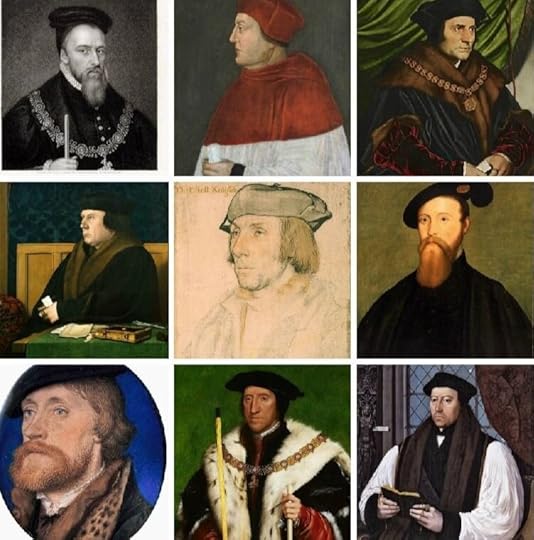
I recently gave a a little presentation of "My Favorite Thomases" for a friend's virtual Renaissance Faire, giving a little information about a number of famous Tudor/Tudor-adjacent Thomases and ranking them somewhat arbitrarily for fun.
Here’s my final ranking and bullet points about why I put each Thomas in each place. Do you agree with my ranking? Or am I totally wrong? Who's your favorite? Who do you love to hate? I'd love to hear your thoughts on all this!
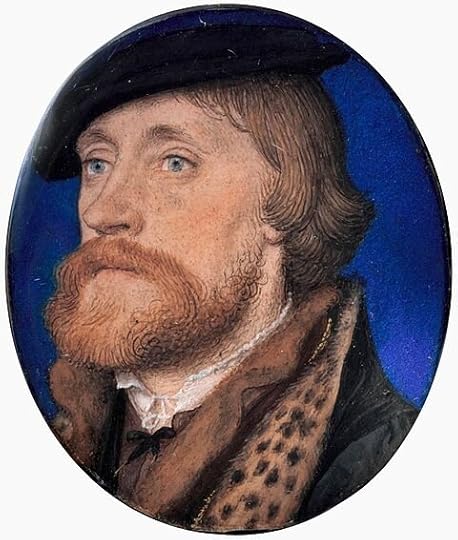
Thomas Wriothesley, 1st Earl of Southampton
10. Thomas Wriothesley, 1st Earl of Southampton
- Served Henry VIII and Edward VI
- Pressured nobles into supporting Henry VIII’s annulment from Catherine of Aragon
- Became wealthy when the monasteries were dissolved, but was happy to persecute Protestants for Henry as well.
- Ambassador to Brussels.
- Friend and employee of Cromwell’s who later turned against him. Claimed Thomas Cromwell was indiscreet with the fact that Henry couldn’t consummate his marriage with Anna of Cleves, helping bring about Cromwell’s execution.
- Personally tortured protestant preacher Anne Askew when the constable of the Tower of London refused to do so. Bishop Stephen Gardiner ordered that she be tortured to testify against Queen Catherine Parr (this was illegal unless the king expressly ordered it and it was unthinkable to torture a woman). The constable flat out refused to do so. Thomas Wriothesley and Richard Rich (both members of the privy council) personally put her on the rack and turned the wheel when the constable of the Tower of London refused to do so. Askew refused to speak. When she was brought out to be burnt at the stake, she had to be carried, as the torture had dislocated her joints and she could not walk.
- Part of the plot to arrest Catherine Parr (Henry VIII’s last wife).
-Lord Chancellor at the time of Henry's death
- Best thing about him: His eyes are pretty in this one portrait?*
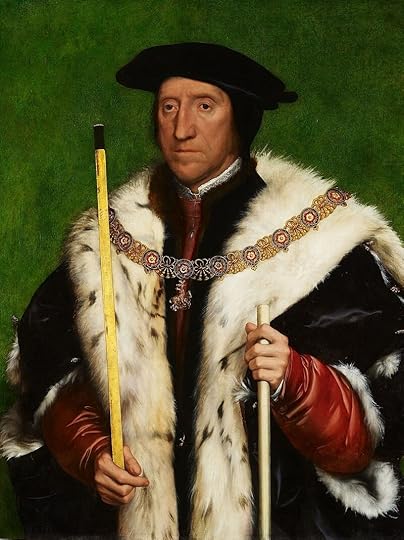
Thomas Howard, 3rd Duke of Norfolk
9. Thomas Howard, 3rd Duke of Norfolk
- An advisor to Henry VIII who had served his father previously. Involved in several military campaigns against Scotland and France. Also Lord Deputy of Ireland, Lord Admiral, and Lord Treasurer for Henry VIII’s household.
- Violently killed many of the Pilgrimage of Grace rebels (Catholics who wanted the monasteries restored) for Henry VIII in 1537.
- Uncle to both Anne Boleyn (Henry VIII’s second wife and mother of Elizabeth I) and Catherine Howard (Henry VIII’s fifth wife). Played a major role in bringing about both their marriages to Henry. He also served on the commission to investigate Anne and presided over Anne’s trial, in which a jury unanimously sentenced her to death.
- Noted political enemy of Cromwell. Helped bring him down in the aftermath of Henry’s failed marriage to Anna of Cleves.
- Became isolated politically in the late days of Henry’s final years as the Seymours grew in power. His eldest son pissed off everyone by assuming the royal arms of Edward the Confessor as his personal heraldry – both were sent to the Tower, his son was executed. Henry assented to Howard’s death.
- Barely survived Henry VIII (was imprisoned and sentenced to death, but Henry died before the sentence could be carried out). Remained imprisoned throughout the rule of Edward VI, released by Mary I who he served for a while in military matters.*
- Worst thing about him: Seemed to really like his wife Lady Elizabeth Stafford for a while, but he took his mistress and literally moved her into the house in 1527, so they lived apart after that. Lady Elizabeth alleged he took her jewels and apparel, locked her in her chamber, and physically abused her.
- One of very few people who actually served Henry VIII from his accession to his death.
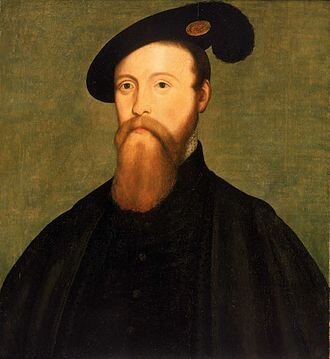
Thomas Seymour, 1st Baron Seymour of Sudeley
8. Thomas Seymour, 1st Baron Seymour of Sudeley
- brother of Jane Seymour (third wife of Henry VIII and mother of Edward VI), made diplomat and ambassador to Brussels, and later, Lord High Admiral.
- Henry VIII seemed to openly dislike him, which is rather hilarious. - married the dowager queen Catherine Parr in secret only four months after Henry’s death, after his attempts to marry both Princess Mary and Elizabeth failed.
- Hit on his pregnant wife’s 14-year-old stepdaughter (Princess Elizabeth) so much that her reputation was nearly ruined. Reports indicate that Seymour’s “flirting” included tickling and slapping her butt as she lay in her bed, or coming into her room in his nightclothes. Catherine Parrr dismissed these reports from Elizabeth’s governess as just innocent fun for a while and joined in a few times (including one weird time where they attacked Elizabeth’s dress with scissors and cut holes in it?). She later became more concerned and sent Elizabeth away to live elsewhere.
- Tried to pressure the 9-year-old Edward VI into signing various bills that would benefit him. Later tried to kidnap his nephew Edward VI and in the process, killed one of Edward’s dogs. Afterward, he was convicted of treason and executed.
- If you’re familiar with Six, he’s who Catherine Parr is singing to at the end. They became “romantic friends” right before Henry VIII proposed to Catherine. Conveniently, Thomas was made ambassador to Brussels shortly thereafter.
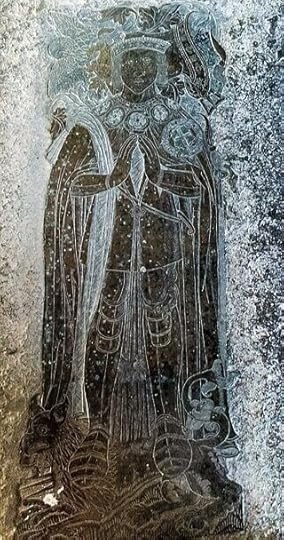
Thomas Boleyn, 1st Earl of Wiltshire
7. Thomas Boleyn, 1st Earl of Wiltshire
-Ambassador to Low Countries and France, Briefly Lord Privy Seal
-father of Anne Boleyn. Very intelligent and capable man who married above his station to Elizabeth Howard.*
-Took great advantage of his daughter’s rise in favor and took on many roles in Henry VIII’s government. Often portrayed as the mastermind of her marriage with Thomas Howard, her uncle, but no actual evidence to support this.
-Served on the secret commission to investigate his daughter’s sexual misconduct and helped lead to her and George’s downfall.**
-Survived his daughter and son’s downfall, but was stripped of his offices and titles. Died three years later (two years after his wife), still in disgrace. His only surviving child Mary died in 1542.
Described by records at the time of Anne Boleyn’s trial as “a mean egotist and coward, and from motives of prudence had always disapproved of his daughter’s bold and violent courses. There was, therefore, no reason to fear that he would try to defend her.” Did not fight for his children’s survival at all (we have records of other of the condemned men’s families fighting tooth and nail for them, but there’s no sign that that Thomas did anything to try to save Anne or George).
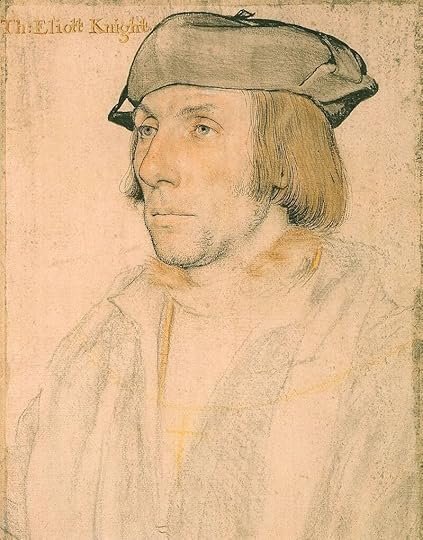
Sir Thomas Elyot
6. Sir Thomas Elyot
- a writer and publisher, English scholar and diplomat, clerk of the Privy Council, high sheriff of Oxfordshire
- Member of Parliament, embassy for Henry VIII on several occasions
- Very relatable. He literally begged Thomas Cromwell not to send him as embassy to holy roman emperor Charles (to try to persuade him to support Henry’s annulment from Catherine of Aragon)
- Educated himself from the age of 12.
- Wrote books supporting education of women and on moral philosophy. He also wrote a dictionary and a eulogy of Anna of Cleves (Henry VIII’s fourth wife).
- one of the first proponents of the use of the English language for literary purposes
- Hans Holbein drew a very lovely picture of him.
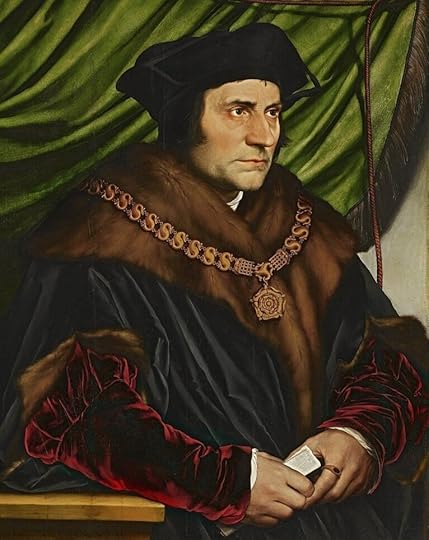
Sir Thomas More
5. Sir Thomas More
- Famous humanist/philosopher. Wrote Utopia (giving rise to a new fiction genre) and History of King Richard III. I’m not a huge fan of his because his history of king Richard iii was often very inaccurate and popularized the view of Richard as a hunchbacked murdering villain (and I raelly like Richard III).
- Gave his daughters the same classical education as his son, influencing other nobles to do the same.
- Henry’s secretary, personal advisor, and lord high chancellor
- Opposed the Reformation, burning six Protestants. Insulted Martin Luther via letter on Henry VIII’s behalf.
- His stubbornness led not only to his own death but to his family’s poverty (those convicted and executed of treason lost all their lands and goods).
- Refused to take the Oath of Supremacy acknowledging the annulment of Henry & Catherine’s marriage and Henry as head of the English church, despite his family’s entreaties.
- Frankly brilliantly argued against his conviction at trial. One who keeps silent seems to consent", understood that he could not be convicted as long as he did not explicitly deny that the King was Supreme Head of the Church, and he therefore refused to answer all questions regarding his opinions on the subject. The evidence again him was pretty weak. The jury only took 15 minutes to convict him (probably had been ordered by Henry)
- Joked upon his death-"I pray you, master Lieutenant, see me safe up and [for] my coming down, let me shift for my self.” He may also have joked about his beard being innocent of any crime, and then positioned his beard so it would not be harmed upon his beheading.
- Canonized martyr and patron saint of statesmen/politicians
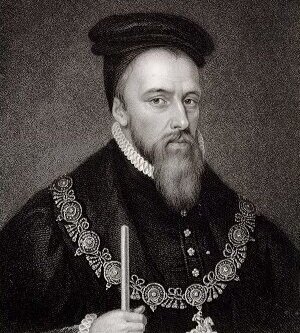
Thomas Stanley, 1st Earl of Derby
4. Thomas Stanley, 1st Earl of Derby
- With his brother, he managed to stay in the favor with every king during the Wars of the Roses, serving Henry VI, Edward IV, and Richard III.
- The Stanleys were slightly notorious for keeping their armies back out of battles until they were sure who would win, and then backing that person.
- Married Lady Margaret Beaufort and helped her bring her son Henry Tudor to the throne as Henry VII by supporting his armies at the Battle of Bosworth, even though Richard III held his son George (Lord Strange).
- Derided as a coward at times but honestly, one of the canniest people during the Wars of the Roses and a born survivor.
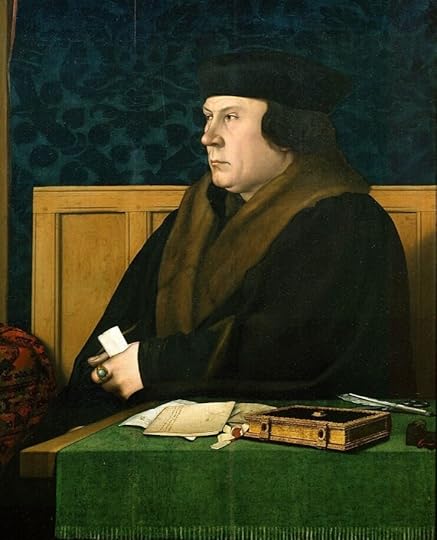
Thomas Cromwell, 1st Earl of Essex
3. Thomas Cromwell, 1st Earl of Essex
- A blacksmith’s son and former mercenary/ “ruffian” in France, Italy, and the Netherlands.
- Became an attorney, a burgess in the House of Commons, and Cardinal Wolsey’s protégé.
- Talked the House of Commons into making Henry the head of the English Church and led the dissolution of the monasteries (which made Henry very rich). Named Henry’s chief minister in 1534.
- Likely manufactured the downfall of Anne Boleyn. Definitely manufactured the dissolution of the monasteries throughout England in the wake of England leaving the Roman Catholic Church. Anne wanted money from the dissolution of the monasteries to go to education instead of the king, which Cromwell preferred.
- Reformed the council of the North to strengthen royal authority there, introduced Protestantism in Ireland, wrote laws which promoted stability in Wales. He also introduced significant social reforms, including poor relief legislation, the promotion of English cloth exports, and taking action against enclosures.
- Arranged Henry’s marriage to Anna of Cleves, from the Duchy of Cleves, a Protestant stronghold. When this didn’t pan out, Henry was pushed by Cromwell’s enemies (including the aforementioned Thomas Wriothesley) to have him executed.
- The only person Henry VIII openly regretted executing.
- Historians
- I’m biased in his favor because of his effect on the keeping of historical records.
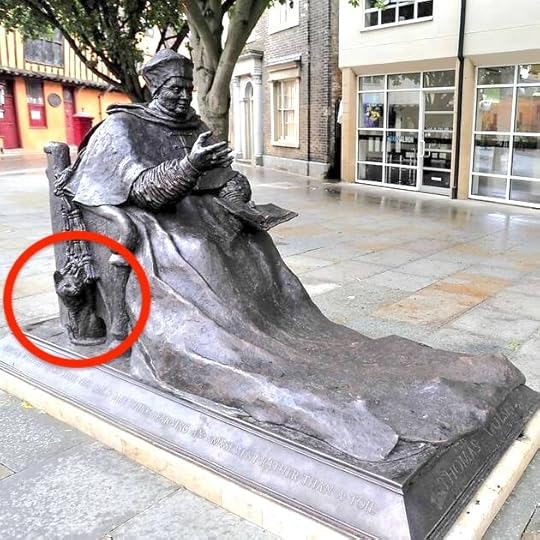
2. Cardinal Thomas Wolsey
-A butcher’s son who ran the kingdom for Henry VIII, serving as his Lord High Chancellor from 1515-1529.
-Made significant and popular legal reforms that allowed nobles to be convicted of crimes.
- Despite being a priest, had a mistress and two children.
- Gave Hampton Court Palace to Henry as a peace offering when Henry was angry at how long his annulment was taking.
- Fell from power after the Legatine Court kicked the can down the road on Henry VIII’s annulment from Catherine of Aragon.
- Extremely unpopular among nobles because of his commoner status and his power. Wolsey was terribly corrupt and got lots of money from his position, but frankly, everyone else did.
- Liked cats so much that his cat features in his statue.
- Sam Neill played him in the Tudors. And I really like Sam Neil.
- He died of illness on his journey to London to answer to charges of treason.
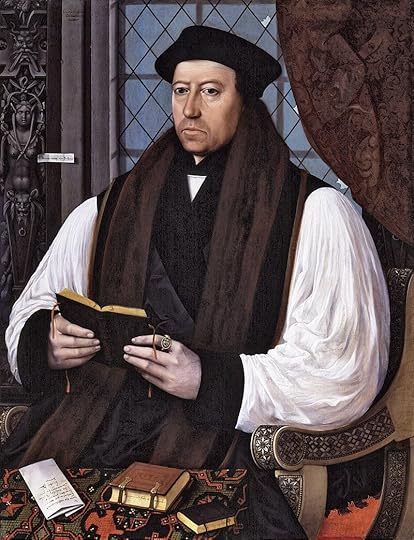
Archbishop Thomas Cranmer
1. Archbishop Thomas Cranmer
- I love Cranmer because he was ahead of his time in many ways, but smart enough and human enough to be flexible and compromise to keep himself alive, as he realized that he could do more for his faith by staying alive than by dying. He actually forgave other people who had done him wrong and personally stuck out his neck to try to protect several condemned people from Henry’s wrath.
- Scholar, Ambassador, Privy Councillor.
- helped build case for Henry's annulment. Traveled around to gather support for the plan. Officiated Henry and Anne’s wedding, pronounced his first marriage invalid, second valid.
- established the doctrine and Book of Common Prayer for the Church of England.
- One of the few people Henry seemed to genuinely love/trust. Begged mercy for Anne Boleyn and Thomas Cromwell. Henry VIII really loved Cranmer and personally sponsored the papal bulls necessary to promote Cranmer to archbishop of Canterbury. He also was deputized to be the person to tell Henry VIII that Catherine Howard was cheating on him, as Henry liked him best. He slipped the message to Henry during mass on All Saints Day.
In the last years of Henry’s reign, when conservatives tried to come after many religious reformers, including Cranmer, Henry himself told Cranmer about the charges and made Cranmer the chief investigator of the matter. Henry gave Cranmer his personal ring to show to anyone who tried to arrest him. Cranmer took initial revenge on the plotters against him but eventually forgave him (which was really rare for the time).
- Genuinely mourned Henry’s death and then grew a beard to mourn the king and reject the old church (continental reformers grew beards to mark their rejection of the old Church and this significance of clerical beards was well understood in England).
- Reformed the church considerably under Edward VI, changing doctrine on the Eucharist, clerical celibacy, veneration of saints, and the role of images in places of worship.
- Imprisoned when Mary I came to power. Over the two years of his imprisonment, recanted a few times and reconciled with the Catholic church, but on the day of his execution, withdrew his recantations to die a heretic.
- Married twice despite being in the church. First, while pursuing his MA, and had to forfeit his fellowship as a result. Later married a Protestant woman he met in Germany (instead of just taking her as a mistress as many priests did) in hopes that Henry would get rid of clerical celibacy and brought her to England in a box. Had two children with her. His family moved to continental Europe when it became clear that Henry wasn’t going to do this.
August 26, 2020
I'm Speaking at the Second Annual TudorCon!
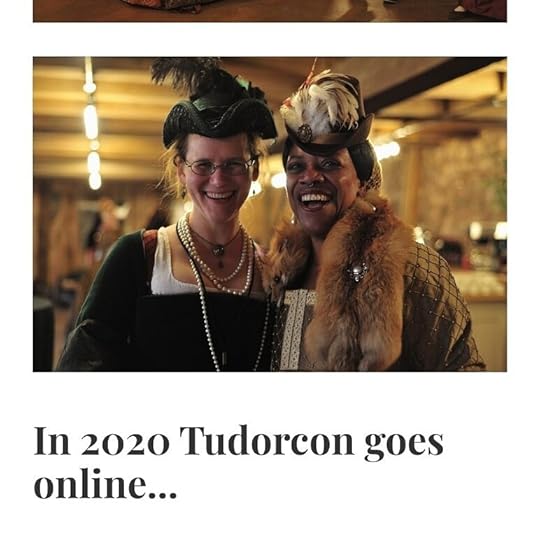
Hey friends! So I'm still speaking at TudorCon this year (on the effects of the wars of the roses on Tudor policy), but now it's all online, so anyone can sign up to watch and listen to all the amazing speakers without even leaving your house! With a $29 ticket, you can watch the events live, get the recordings of all the talks, see a Tudor cooking demo, and get a virtual goody bag! I ran the Livestream for TudorCon last year and, y'all, the community of Tudor fans is just wonderful and so interesting to talk to. We traded so many favorite facts and book recommendations. If you're interested in Tudor history at all, I really encourage you to sign up, as it's a total blast.
I'll be updating this post with more photos from TudorCon last year soon, just gotta dig them up! :) And I'll likely give a preview of some of my presentation in September sometime, just for a taste of what I'm talking about.
You can buy your tickets here!
August 16, 2020
More Zatoichi Film Reviews!
The first four Zatoichi film reviews (and number 20)
I’m finally getting around to finishing up my quick reviews of/thoughts about the Zatoichi films, which I started in late May. Zatoichi was featured in 26 films from 1962-1989 and a 100 episode TV series in the 70s. Think of him like a Japanese Daredevil from the 1800s. I’ve now watched all of the films except the very last one, but we haven’t been able to figure out how to access the TV series yet.
By the way, the main character’s name is simply Ichi. “Zato” refers to the lowest ranking in the Todoza, which was a guild for blind men (there actually was a different guild for blind women). Edo society was HIGHLY socially stratified with little to no opportunities to change your career or life really, so Zatoichi’s title reflects that. This social stratification is a recurring theme throughout the films. Ichi is basically one of the lowest ranking members of the society, partly as a result of and in addition to his blindness, which is a big reason why his skill with the sword always surprises everyone. In addition, during the Edo period, technically only men in the samurai class were allowed to carry swords, but this wasn’t enforced very well. As a result though, Ichi always uses a cane sword, which he keeps hidden within the cane until he really needs it.
Oh! So “yakuza” as its used in the films means “gangster.” Apparently the term actually originates from a traditional card game called Oicho-Kabu. I briefly tried to understand the rules of this game so I could explain it in more depth but quickly gave up – basically, tl;dr – “Ya-ku-za” is made up of the three numbers which create the worst possible hand that can be drawn in the game.
On to the actual little film reviews! *** Indicates my favorites!
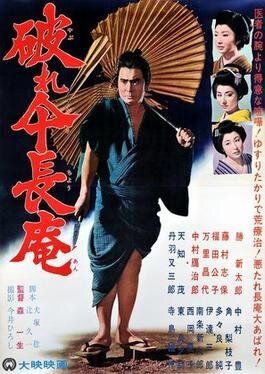
Zatoichi on the Road
5. Zatoichi on the Road (Directed by Kimiyoshi Yasuda, 1963)
At the beginning of the film, Ichi has to kill a few gangsters who attack him and his guide (who lasts only a few minutes in the film). He meets Hisa, one of the dead gangster’s wives immediately afterwards, who is strangely callous and calm when she tells Zatoichi that he just killed her husband (because they attacked him). Shortly thereafter, Ichi is asked to escort a girl named Mitsu to her wealthy family in Edo. Mitsu is in trouble and currently hiding out, as she stabbed a local lord in the face with her hairpin when he tried to rape her (GOOD FOR HER).
There’s a great scene where Ichi ends up talking about himself to someone who knows of him but doesn’t recognize him AS the great Zatoichi. He disparagingly says that Ichi learned how to fight and people have been following him and trying to kill him ever since and it’s all a terrible bother. It’s an interesting character development point.
Hisa continually tries to interfere with Ichi’s attempts to save Mitsu and at one point persuades Mitsu that Ichi is actually going to hurt her and gets her to leave. Hisa immediately brings Mitsu to a gangster, who tries to hold Mitsu for ransom, but Ichi ends up finding her and fighting everyone to save her.
More shenanigans ensue as Ichi tries to keep Mitsu safe and more gangsters try to kill him and her. Ichi continues to show a great ability to tell the difference between good people who just happen to be involved in gangs and gangsters who actually are terrible people.
There are a couple of interesting details in this film. There’s a running joke with sour persimmons; Ichi first tries one and makes a terrible face, then later forces a scoundrel to eat a persimmon before showing him to the door. At one point, a group of children chases and laughs at Ichi (why do children tease blind men so often in the Zatoichi films), but he doesn’t seem to mind and actually is quite delighted to play with them.
This film has some Very 60s soap opera style music at the end, complete with an organ.
By the end of the film, Ichi is very clearly in love with Mitsu but knows it would never work out with them. He asks a friend to take her to a boat to safety. They wait for him for a while but eventually they realize that he isn’t joining them. At the end of the film, he walks off alone, smelling a kerchief that he kept of hers to remember her by.
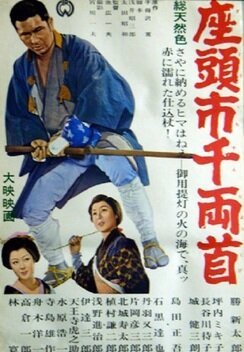
Zatoichi and the Chest of Gold
6. Zatoichi and the Chest of Gold (Directed by Kazuo Ikehiro, 1964)
This one has a very 60s James Bond style beginning, with the fights happening against a black background with no distinguishable setting, all against orchestral actiony music. Husband John joked, “He may have a higher body count just in the credits of this film than he does in any other movie.”
Ichi walks in to a village that’s celebrating paying off their huge tax debt and they invite him to come join them with their feasting and dancing. He ends up even playing drums for a while. So much of this film series concentrates on Ichi’s overwhelming sadness and melancholy that it’s really fun to see him let loose every once in a while.
So the tax payment ends up getting stolen, which was entirely foreseeable, since these assholes are carrying their 1,000 Ryo tax payment on a horse with a giant sign that says “tax payment” on it. Are they TRYING to get robbed blind? The tax payment theft gets blamed on Ichi (who just happened to be nearby when the robbery happened and ended up sitting on the chest for a while, thinking it was just some random thing) and Boss Chuji, the local yakuza/Robin Hood figure, but ultimately it ends up that a corrupt magistrate actually stole it all. Lots of complications ensue but ultimately Ichi gets the villagers their money back. At the end, he slowly walks toward the villager’s celebration music while his face is covered in scratches and tears, theoretically to join them, but at the end of Zatoichi’s films, he typically just wanders away without a goodbye, so it’s hard to tell.
This one includes some VERY 60s organ and film transitions here- like spinning video like in Batman. There’s a funny scene where Ichi is interacting with a sex worker who apparently really needs to take a bath where he’s just trying to get away from her and it’s the weirdest funniest thing.
Recurring Zatoichi element: Calling out other dudes being jerks to women. At one point he goes into an onsen (a bathing facility) for women joking about how he can’t actually see anything, but then ends up splashing water on the peeping toms looking through a a wall.
The whole “a combatant in a fight is already dead before he actually moves and falls to the ground thing” is such a cliche but i love it anyway.

Zatoichi’s Flashing Sword
7. Zatoichi’s Flashing Sword (Directed by Kazuo Ikehiro, 1964) ***
This film opens with a really artsy and beautiful opening shot aimed straight down into the room where the action is happening. The camera ends up moving around like it’s on the back of a fly that Zatoichi ends up cutting in half with his sword.
Here’s another movie in a row with a good yakuza and a bad magistrate. In this one, the good yakuza keeps the prices for the ford across the river low to avoid burdening the locals. Here, this “ford” consists of strong burly men carrying people across on their backs. It’s such an interesting cultural detail that I don’t think you’d see in the west, even back in the 1800s, as you end up being carried across the river by perfect strangers. The workers at the ford literally climb underneath the outstretched legs of their passengers to get them positioned on their shoulders.
The ford becomes a huge bone of contention as the bad magistrate tries to take control of it away from the good yakuza and charge the locals more money for it all. Ichi stays with the good yakuza for a few days leading up to the festival after helping put an end to some fights around the ford and ends up helping him out in other ways as well.
During all the back and forth, Ichi is attacked while crossing the river and ends up going underwater to fight his assailants. The underwater sword fight was extremely cool. He manages to kill them all from below and had to check their bodies with his sword to make sure they were dead. Apparently this was a real thing and lots of the original freestyle swimming competitions in the Olympic s were easily dominated by the Japanese, because they were used to training in swordfighting in water.
At one point, a samurai working for the evil magistrate references Ichi’s fights with the samurai master Miki Hirate (from the first film, The Tale of Zatoichi), yakuza boss Sukegorō Hanoka (from the second film, The Tale of Zatoichi Continues), and a magistrate in other province (Zatoichi and the Chest of Gold). Ichi’s fame has really grown. I’m sad that his reputation ends up persuading the good yakuza send him away before the fireworks show he desperately wants to see, as they’re afraid of him. Ichi is awesome though and continues to help them and fight their enemies for them. Interesting thing - they knew he was a blind man named Ichi but didn’t connect he was Zatoichi BECAUSE Ichi was apparently a very common name for blind men acting as masseurs, although usually they have some other name as well. I think the overall commonness and humility of his name ties in very well into the series and character’s overall feel.
There’s a wonderful repeating joke in this film where Zatoichi, the blind man, tries to talk to the fireworks maker, a deaf man.
I love how people see him fight and kill multiple people really quickly and STILL ask “what can you do, you’re blind?” This film features a moment where Zatoichi just goes Kill Bill on all the bad guys as the fireworks go off in the background quite beautifully. Ichi is overall so patient and calm and chill when people harass him for his blindness that it’s impressive when he loses his shit. “I’ve had about all I can take from you.”
Recurring Zatoichi element: “In the dark I have the advantage; it turns you all into blind men.” His trick of cutting a candle in half so the flame falls escalates in this film, where he’s actually fighting with a lit candle top on his sword for a while.
Recurring Zatoichi element: Calling out other dudes being jerks to women. In one small scene, Ichi pretends to be a peeping Tom with a few other men and then loudly asks everyone if they’re looking at the woman to alert her to their presence.
Zatoichi Girl whose name starts with O: For some reason many women in the series that have some sort of possibly romantic relationship with Ichi have names starting with O. This film’s version is Okuni.

Fight, Zatoichi, Fight
8. Fight, Zatoichi, Fight (Directed by Kenji Misumi, 1964) *** (This is actually my favorite Zatoichi film of them all!)
As the series goes on, they’re clearly trying to differentiate the films’ beginnings in new and artistic ways. This one opens with a focus on Zatoichi’s feet and sandals as he’s walking along a path, including a moment where he even steps in manure (ew). There’s also a sweet blind man’s pilgrimage where they all claim to be named Ichi to fuck with the people looking for Zatoichi and hide him to the side somewhere. (although as I mentioned previously, Ichi was apparently a common name for blind masseurs at the time). This blindman’s pilgrimage will show up twice more in the film.
The whole plot of the film really gets going when a woman is tragically killed in a palanquin, as his enemies thought Zatoichi was in it (he had just given up the palanquin to the woman, who was tired from walking). It’s really tragic, as the baby is just like, crying while still held in his dead mother’s arms, ack.
Shortly after, as the people in the nearby village help Ichi figure out what’s going on (reading through the woman’s papers to find her identity and such) and prep him to go take the baby to his father, the baby pees in ichi’s face. Because why not.
Later, Ichi hears a woman singing a very disturbing lullaby to a baby about its mother dying while she herself is walking on a very thin bridge while Ichi watches her with HIS orphaned baby from a thicker bridge. This lullaby will come back twice more in the film and also plays as an instrumental at various points.
As he travels throughout Japan, Ichi is just dropping the kid’s dirty diapers in creeks wherever he goes? People DRINK out of those creeks, Ichi. Ichi improvises with the baby by giving him a leaf to play with. In one hilarious scene, he asks a woman to lead him to a scarecrow in a field, and then assaults the poor scarecrow (as the woman watches in confusion) to take his clothes and flags from the fence for diapers.
There are multiple funny moments where Ichi balances child care with fighting for his life. While changing the kid’s diaper, his enemies try to kill him and he kills like five of them, while keeping the baby safe the whole time. He actually says straight out, “seriously, you can’t just let me change this kid’s diaper?” At another moment, he shushes a dying man, as the baby is sleeping.
There’s a very cute scene where he’s at a gambling table with the baby, conferring with the baby over whether to bet odd or even. Later, when he figures out that the game is fixed, he throws the baby into a woman’s arms for safety so he could reveal the loaded dice switch.
That night, he hires a sex worker just to take care of the baby while he sleeps (I LOVE HIM). He gave her rice water to feed him and a string rattle to play with him. “Aren’t you lucky, going to sleep with this pretty lady?” He is the cutest helicopter parent and keeps checking on him, even feeling for his breath while he sleeps, aww.
A random thief lady named Oko comes along and ends up joining Ichi on his journey to help him with a child, falling for Ichi in the process, of course. They encounter the blind men’s pilgrimage again and they happily greet the woman and the child, assuming that they’re his family.
Don’t let a baby pee off a balcony y’all. They might pee on a sumo who then threaten to kill you. Immediately after this incident, Ichi ends up fighting a ton of people with fire because of course he does.
Toward the end of the journey, right before he’s about to bring the baby to his father, he drives Oko away with harsh words and pretends not to love the child when he in fact really does. The moment she leaves, he picks up the kid and is like “don’t listen to anything I just said” and sings him the lullaby.
Shenanigans ensue but ultimately the baby’s father ends up being a jerk who denies him as his own. Ichi briefly thinks he’s going to adopt the child and raise him as his own, but ultimately gives him to a kind monk who politely suggests that the kid would likely be better off being cared for in a temple rather than traveling on the road with a blind yakuza. Ichi walks away at the end singing the creepy lullaby and playing with the kid’s rattle, clearly very distraught at the loss of the child.
At the very end, the blind men’s pilgrimage walks past him, the third time we’ve seen them. Ichi ends up looking at them but says nothing to announce his presence. He doesn’t want to answer their questions about the child or the wife. (HEART BROKEN FOREVER)
Recurring element: Ichi reveals that the dice in a gambling den are loaded, making enemies, of course.
Zatoichi Girl whose name starts with O: Oko
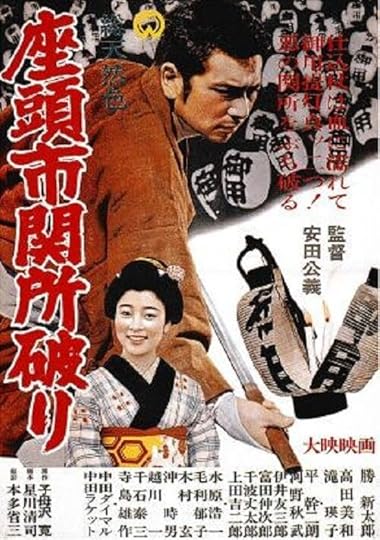
9. Adventures of Zatoichi (Directed by Kimoyshi Yasuda, 1964)
I don’t have a ton of notes on this film, as it’s well done but is a very complex story with lots of different minor but important characters and different plots running throughout it. Ichi gets involved with delivering a note to Sen, a woman at an inn, from a stranger yakuza. Also at the inn is Saki, a woman hunting for her father, a town chief who’s gone missing. This film also features Giju, an old drunk who may be Ichi’s long lost father, which leads Ichi to trust him, even though he likely shouldn’t.
It’s all set in the background of a New Year’s celebration, which is really beautiful and fun. A festival air pervades it all. A local magistrate and a corrupt yakuza though, have raised rates for the festival and are demanding an exorbitant cut of the revenues from the vendors who have come into town to entertain the populace. These entertainers are a fun bunch and include some musical duos and a Statler and Waldorf style comedy duo.
All of the stories end up becoming intertwined in various ways. It’s a good film, but I personally found it a bit confusing to follow. There’s a later film in the series (Number 11, Zatoichi and the Doomed Man) which has similarly intertwined stories, but is executed in a much clearer and less confusing way.
Recurring element: Zatoichi befriends random children. Two acrobat kids end up helping Ichi throughout the film as he tries to save the day.
Recurring element: Ichi exposes loaded dice while gambling.
August 12, 2020
Announcement: Tudor Watch Party series!
Hi everyone!
I’m going to start hosting various virtual watch parties of specific Tudor/Tudor adjacent films and TV series and discussions afterwards over on my Author Facebook Page. I’ll hold these parties occasionally, probably around once a month, and will be alternating between more modern productions (The Tudors, The White Queen, The Other Boleyn Girl) and older productions (The Private Life of Henry VIII from 1933, Carry on Henry from 1971, etc.).
I won’t be doing a live cast or anything, but will instead ask people to watch the media for that week (or a selection of it, for a long series like The Tudors) and then we can discuss it all later. I'll write up little reviews of the media and highlight the best parts of the discussion on my blog afterward.
Warning, the vast majority of media about the Tudors/Tudor adjacent British monarchs is just hilariously historically inaccurate, but it should be great fun to discuss it all and tear it all apart. I'm generally willing to watch even bad television/films and laugh about them later. I only was able to get through like, two episodes of Reign before I turned it off forever though, hahah.
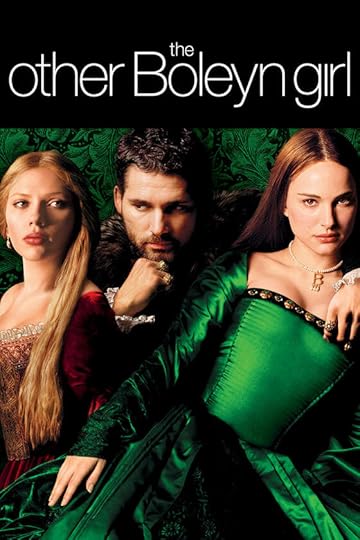
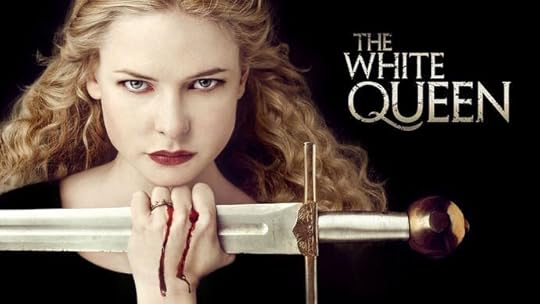
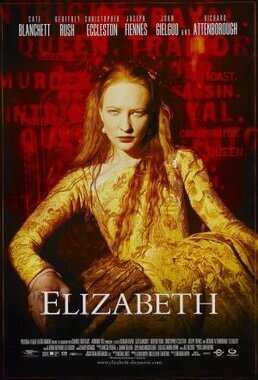
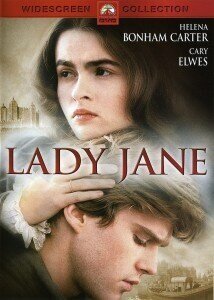
Here's a short list of possible media selections for our first week of watching. Let's say that this is for the week of August 16-22 - I'll post up a discussion link on Sunday and we can all jump in with our thoughts throughout the week. Vote for your favorite option!
1. The Other Boleyn Girl (film starring Natalie Portman, Scarlett Johansson, and Eric Bana - Henry VIII/Anne Boleyn/Mary Boleyn - 2008)
2. The White Queen (miniseries starring Rebecca Ferguson, Amanda Hale, and Faye Marsay - Elizabeth Woodville/Margaret Beaufort/Anne Neville/Wars of the Roses - 2013. I'd select one episode in particular to concentrate on but the whole TV series would be up for discussion if we choose this)
3. Elizabeth (film starring Cate Blanchett - Elizabeth I - 1998)
4. Lady Jane (film starring Helena Bonham Carter - Jane Grey/Edward VI/Mary I - 1986)
Announcement: Weekly Tudor Film/TV Series "Watch Party"!
Hi everyone!
I’m going to start hosting various virtual watch parties of specific Tudor/Tudor adjacent films and TV series and discussions afterwards over on my Author Facebook Page. I'm I’ll hold these weekly and alternating between more modern productions (The Tudors, The White Queen, The Other Boleyn Girl) and older productions (The Private Life of Henry VIII from 1933, Carry on Henry from 1971, etc.).
I won’t be doing a live cast or anything, but will instead ask people to watch the week's media (or a selection of it, for a long series like The Tudors) and then we can discuss it all later. I'll write up little reviews of the media and highlight the best parts of the discussion on my blog afterward.
Warning, the vast majority of media about the Tudors/Tudor adjacent British monarchs is just hilariously historically inaccurate, but it should be great fun to discuss it all and tear it all apart. I'm generally willing to watch even bad television/films and laugh about them later. I only was able to get through like, two episodes of Reign before I turned it off forever though, hahah.




Here's a short list of possible media selections for our first week of watching. Let's say that this is for the week of August 16-22 - I'll post up a discussion link on Sunday and we can all jump in with our thoughts throughout the week. Vote for your favorite option!
1. The Other Boleyn Girl (film starring Natalie Portman, Scarlett Johansson, and Eric Bana - Henry VIII/Anne Boleyn/Mary Boleyn - 2008)
2. The White Queen (miniseries starring Rebecca Ferguson, Amanda Hale, and Faye Marsay - Elizabeth Woodville/Margaret Beaufort/Anne Neville/Wars of the Roses - 2013. I'd select one episode in particular to concentrate on but the whole TV series would be up for discussion if we choose this)
3. Elizabeth (film starring Cate Blanchett - Elizabeth I - 1998)
4. Lady Jane (film starring Helena Bonham Carter - Jane Grey/Edward VI/Mary I - 1986)
August 11, 2020
U.S. Jurisdictional Approaches to the Bar Exam During COVID-19: Why We Desperately Need Diploma Privilege
I’ve written briefly before on diploma privilege on my blog and have been advocating for it on my private facebook page for months, but this’ll be the first really big overview of all the jurisdictions and the issues with each approach I’ve written up. I prepared this with the intention of talking on the subject at the virtual PAD Convention last week, but alas, we ran out of time. Hopefully this is useful anyway.
Quick Introduction (before getting into specific jurisdictional approaches):
The Normal Stress of the Bar Exam (pre-pandemic)
Let me start this out by noting that even in non-pandemic times, the process of studying for and taking the bar exam is an inherently stressful experience, both emotionally and financially. Each jurisdiction in the United States has different requirements for acquiring a legal license, but generally, you need: 1) a juris doctor degree acquired from a law school (a 3 year course full time and 4 years part time), 2) a passing grade in your jurisdiction on an ethics exam (often the Multistate Professional Responsibility Examination, or MPRE), 3) pass a Character and Fitness screening process/background check, and 4) pass the bar exam.
I’m not going to delve deeply into the huge expense of all of these items right now, but trust me when I say it’s a lot of money. The bar exam in Illinois, for example, costs $950 to take, and to properly prepare for it, you pretty much HAVE to pay for a professional bar prep program, which generally run $1,699+ (many of the big courses are over $2,000). It’s highly advised that you study full-time for the bar exam for around 2 months, and /don’t work/. The bar exam usually runs for 2-3 days and is only offered twice a year (and in some jurisdictions, only once a year). You generally won’t find out whether you passed or failed the bar exam for many weeks to many months afterward. If you don’t already have a job offer from a firm or an agency secured (contingent on you getting that licensure), you have to start job hunting without knowing whether you’ll be licensed or not. If you fail, you have to go through the whole process again, spending more money and time to pursue that passing score.
So even in the best of times, the bar exam process is incredibly expensive, stressful, and can cause a huge amount of financial hardship and uncertainty for test takers.
Bar Exams During a Pandemic
In the COVID-19 world we live in now, there are even more issues. Many jurisdictions have changed their bar exam plans multiple times, sometimes only a week or so before the original date. This causes a huge amount of mental and financial stress on test takers, as they now have to figure out how to support themselves for another 1-3 months until they can take the test.
Financial Concerns: Can they make their money last? Do they need to get a job to survive (against almost all bar prep advice)? If they search for a job, will they even be able to find one (there is a global recession on, after all)? If they already secured a job offer at a firm or an agency, is that offer still good (many businesses and governmental organizations have had to rescind their offers due to - recession, uncertainty of when law licenses will be acquired)? In some jurisdictions, like Delaware and Palau, the 2020 exam has been cancelled altogether, so test takers in those areas now have to figure out how they can make it through the next YEAR without a law license that will allow them to practice in their field.
Mental and Physical Health: Mental and emotional health issues are on the rise for everyone right now, given the pandemic and a global recession. Anyone who’s dealing with more immediate troubles, such as unemployment, illness or death in their families, and possible eviction, is going to be struggling even more. This constant stress and anxiety has a huge impact on a test taker’s ability to focus or study. In addition, the uncertainty behind when, where, and how a bar exam will be held means that it’s difficult for test takers to actually plan their studying (remember, several exams have been postponed or cancelled at the last minute). The bar exam tests such a wide variety of subjects that generally, test takers have to cram everything in their head over two months and hope that they reach the apex of that information curve right at the exam time, right before they forget it all (it’s basically impossible to hold on to all that knowledge for long). All the bar prep courses are designed to fit within that two month study period; what do you do when that two months extends to three, four, or five months? How do you retain what you’ve learned when you don’t know when those exams will happen?
Now let’s get into specific issues with each individual approach.
Quick disclaimer: I got almost all this information from the NCBE and plan to update it as I go with more information from various news sources. I don’t know the ins and outs of every jurisdiction, so there may be some outdated information on this. I am personally barred in Illinois, so I’m most familiar with the issues there. As you’ll see, this is a very complicated issue that jurisdictions are dealing with in a variety of different ways, and it’s all changing very quickly, so if anything is outdated or inaccurate, I apologize. You can always give me corrections via comment or via email at RachaelDickzen@gmail.com.
Almost all information here is from the National Conference of Bar Examiners, compiled 08/08/2020 from “ July 2020 Bar Exam Status by Jurisdiction ” (table form, broken out by date of exam)) and “ July 2020 Bar Exam: Jurisdiction Information ” (map and chart, broken out by jurisdiction)
UPDATED 08/11/2020 with new information [underlined, with sources linked]
1. Jurisdictions who gave an in-person July bar exam
· Arkansas, Colorado, Iowa, Mississippi, Missouri, Montana, North Carolina, North Dakota, Oklahoma, South Carolina, South Dakota, West Virginia, Wisconsin, Northern Mariana Islands

Health Concerns: Bar exams, particularly in larger jurisdictions, often have hundreds (maybe even thousands?) of test takers in one large space, like a stadium or a conference center. Here’s a photo of what the bar exam looked like in Chicago when I took it in July 2015. Yes, it’s just as insanely intimidating as it looks. This was actually one of two locations for test takers in Chicago then.
Reports that have come in from various jurisdictions that gave in person July bar exams have been…concerning. All the usual pandemic concerns apply here: Is everyone there wearing a mask? Is social distancing being enforced? However, the very high stakes of a bar exam, the fact that this exam is offered only 1-2 times a year, and the huge expense and time commitment involved in studying for it means that there is a rather high incentive for test takers to go to take the bar exam even if they’re feeling sick or have tested positive for COVID-19. Although jurisdictions were taking test takers’ temperatures, it’s totally possible that someone was missed.
I also saw lots of reports from test takers that social distancing was NOT being enforced and that they were really uncomfortable with how close they were to other people but….what could they do? They really didn’t have any choice in the situation. Keep in mind most bar exams ban you from having a phone anywhere near you; you definitely have to leave it way far in the back of a room or sometimes even at home. There’s often no way to call for help or document what’s happening.
It’s a little too soon yet to determine if people got sick from in person bar exams yet, but there was a report that came out immediately after the Colorado bar exam indicating that a test taker had tested positive from COVID-19 that advised everyone in a specific room to get tested. And seriously, how can you concentrate on one of the most important tests in your life while you’re worrying about whether you’ve contracted a highly contagious disease that’s killed over 163,000 people in the US and whether you might now be carrying it home to your family?
Administrative Concerns: In pandemic times, you obviously can’t have that many people crammed into one room and certainly not that close together at tables, so you’ll need more rooms, more spaces, and more proctors to administer the exam. So you’re bringing in more people, more places, and more passing in hallways to get to the various locations. Administratively, it becomes even more complicated.
2. Jurisdictions planning to give a delayed in-person bar exam
· September – Puerto Rico (Although the NCBE website actually says that Puerto Rico gave its exam in July, I spoke with a lawyer in Puerto Rico on Saturday and found out that that is definitely NOT the case. Thanks for informing me, Irma Morales! Sorry, I haven’t been able to nail down the exact date yet because the website is all in Spanish, but I’ll try to figure this out soon).
· September 9-10 – Alaska, Guam, Hawaii, New Mexico
· September 30-October 1 – Maine, Rhode Island, Utah
· July and September 9-10 - Kansas, Minnesota, Nebraska, Virginia (one-day exam, Sept. 10), Washington
· July and September 30-October 1- Alabama, Wyoming
· July and October 5-6 - Arizona, Idaho, Oregon
Health Concerns: All the previously stated in-person health and safety concerns apply here.
Mental Health and Studying Concerns: Given how many states have changed their plans for in person exams with extremely short notice, exam takers are in a huge state of uncertainty as to whether they will actually be taking the exam on the stated date or not, which leads to all the financial uncertainty and studying difficulty noted in the introduction.
3. Jurisdictions with multiple dates and multiple testing options
· Oct. 5-6 remote exam offered as an option in addition to in-person July - Arizona, Idaho, Oregon
· Oct. 5-6 remote exam offered as an option in addition to in-person Sept. exam - Texas
4. Jurisdictions that gave a remote July bar exam
· Michigan
Remote Exam Software Issues: Michigan is the only remote exam that’s been given so far, and thus, was the ONLY jurisdiction with a remote exam in July. It still had a ton of problems. The software crashed on the first day, which locked out some test takers for 10 - 37 minutes. The software company tried to blame this on a cyber attack, but many think this was an excuse and the software was simply just overwhelmed. The board of examiners said afterward that no data was compromised and test takers affected were given extra time, but that probably wasn’t very comforting to the many test takers who were anxiously freaking out at the time. Keep in mind that when a glitch in 2014 kept bar exam takers from being able to file their completed first-day tests electronically (after the bar exam, not during it), Examsoft ended up paying $2.1 million to settle all the class-action claims that resulted. This crash took place, DURING the bar exam, and all those test takers had to get right back to answering all the questions immediately after it happened. I can only imagine the panic attacks that were happening.
Recently (as in August 7, 2020), a large bar exam software company, Extegrity, said that it will not be providing software for remote bar exams this year. They stated that their software was not developed for large scale, simultaneous start high stake exams and that remote proctoring carries undue risk for the October exam.
5. Jurisdictions planning to give a remote delayed bar exam (proctored)
· August 19 - Florida (one-day exam, Aug. 19) (The planned test of the software on August 10 was postponed after numerous problems with it were identified after downloading it, Florida Board of Bar Examiners website)
· August 24 or October 10 – Louisiana (in addition to diploma privilege option - cancelled its planned July bar exam in favor of these approaches)
· October 5-6 – California (lowered passing score 50 points ), Connecticut, District of Columbia, Georgia, Illinois, Kentucky, Maryland, Massachusetts, New Hampshire, New Jersey, New York , Ohio, Pennsylvania, Tennessee, Vermont, Virgin Islands
Remote Exam Administration and Safety Issues: Remote bar exams are generally proctored by a combination of people watching webcam feeds and cheating detection software. I’ll get into the cheating detection software more later in this section. From a practical standpoint, you need a LOT more people to watch a lot of individual webcam feeds than you do to watch hundreds of people shoved into one room.
From a safety and privacy standpoint, a lot of people are very creeped out by remote test-proctoring. Although I don’t think any bar exam plans to do it as intensely as is described in this article from The Verge, the situation is similar enough to pose concerns. I’ve read reports of female test takers receiving Facebook friend requests from their male exam proctors after they’d literally watched them take an exam for several hours as well, which is….extremely creepy.
Remote Exams’ Effect on Less Privileged Test Takers: Even assuming the software was entirely reliable and trustworthy, not every test taker has the same access to reliable internet, computers, webcams, or a private, quiet space. Remember we’re in a global pandemic and recession, plenty of people just don’t have the financial ability to rent a hotel room, or buy a new computer or webcam. Many jurisdictions have put very strict rules in place which ban any person or pet entering the room during the exam, which causes issues for parents or pet owners who can’t afford or find a sitter during a pandemic, or for those who live in small spaces with roommates or family members.
Remote Exams’ Effect on Test Takers with Disabilities: Some test takers who qualify for accommodations for the bar exam have been told they can’t get those accommodations remotely and need to come in for an in person test. In addition, rules designed to prevent cheating have resulted in bans on leaving the room, even for a bathroom break, which can pose issues for pregnant test takers or those with disabilities. One test taker who’s 8 months pregnant said that her accommodations request for bathroom breaks was straight up denied, so flexibility doesn’t seem to be a rule here.
Remote Exam Security Technology Bias: Cheating detection software is the big reason why test takers are banned from leaving the room and why any person or pet is banned from entering the room during the exam; it could throw up a flag and cause problems for you later even if your cat walks in (presumably most people’s cats are not experts on adverse possession law).
In addition, remote proctoring uses facial recognition technology to ensure that the same test taker is logging on to the exam for each module. Studies have shown that current facial recognition technology is biased towards a white male dataset and often causes issues for female test takers, test takers of color, or anyone who doesn’t conform to a traditional “white male” look as recognized by a computer. This can lead to problems and delays for bar exam takers trying to log on to take their test after a lunch break. And when you’re taking such a high stakes, expensive test, every moment counts.
6. Jurisdictions that gave a remote delayed bar exam (open book, non-proctored)
· Indiana (one-day exam, Aug. 4)
· August 11-12 – Nevada [UPDATED, i just learned that Nevada also decided to offer their exam as an open book non-proctored exam. Nevada used the same vendor that Indiana used and Indiana’s test caused Nevada to push back its exam two weeks. Some test takers reported that there were still issues with the software used by Nevada during practice sessions.]
This entire approach was developed in response to the “repeated and unforeseen technical complicates” that resulted when Indiana tried to test its bar exam in July.
7. Jurisdictions granting extensions of supervised/provisional practice rules
· Arkansas, California, Colorado, Connecticut, Georgia, Illinois, Kentucky, Massachusetts, Missouri, Montana, New Jersey, New York, Ohio, Pennsylvania, South Dakota, Tennessee, Vermont
Disclaimer: This is the approach I know LEAST about. Jurisdictions are taking very very different approaches toward this - in some places, it may just be an extension of supervised practice student license rules. Other jurisdictions may allow for more autonomy on the part of the temporarily licensed lawyer.
Financial Issues: Either way, this really isn’t a satisfactory approach. Those with temporary licenses are still going to have to take 1-2 months off work in the future to study for the bar exam, and given the state of the world, it’s hard to guess when that time will be. Employers are going to be really disinclined to hire someone knowing that they’re going to have to give them that time off in the future for them to remain licensed. In addition, employers will definitely use a provisional license as an excuse to pay those holding that license less.
8. Jurisdictions granting diploma privilege
· Diploma Privilege as an option, may take in person exam – Louisiana, Oregon, Washington
· Diploma Privilege alone – Utah
· [UPDATED} Wisconsin already allows graduates of the two ABA accredited law schools in the state to seek admission to the state bar without having to sit for a bar exam and has done so since 1870. Graduates of out-of-state law schools must still take the bar exam to be admitted there.
I, obviously, support diploma privilege as the best option of all of these approaches. But even this option has numerous issues with it. Will employers accept licenses acquired through diploma privilege as valid or good enough? Will other states grant reciprocity? These concerns are real enough that Louisiana, Oregon, and Washington is still offering bar exams as an option to graduates who are concerned that diploma privilege won’t be enough.
Administratively - is it only accredited law school graduates that get diploma privilege? What happens to graduates of an unaccredited law school? Will those graduates alone be forced to take the bar exam?
Some people have voiced concerns that we’ll have unqualified lawyers if we grant diploma privilege. I personally think this is ridiculous, the bar exam tests memorization and short term recall far more than your actual ability to practice the law. Legal practice is almost always open book and you’re rarely going to be put in a situation where you need to spout off memorized facts and laws at a moment; even when that situation comes up, you’re likely to have ample time to prepare.
9. Jurisdictions that have denied petitions or requests for diploma privilege
· Alaska, Idaho, Illinois, Minnesota, Missouri, Nebraska, Nevada, North Carolina, Ohio, Pennsylvania, and Tennessee
10. 2020 Exam cancelled
· Delaware, Palau
Test takers in both of these jurisdictions will have to wait until July 2021 to take a bar exam and pursue licensure. This will obviously lead to lower pay and potential inability to get a job in the field you’ve trained for. Test takers will have to take 1-2 months off work next year to study for the exam, which will make employers pretty unhappy. Overall, it just leaves a lot of test takers in limbo.
Obviously, despite writing over 3,000 words on this subject, this is just the tip of the iceberg. There’s a lot I haven’t talked about and a lot we don’t know. But please, if you’re convinced by my arguments here, join the fight for diploma privilege. United for Diploma Privilege has a pretty good run down of the organizers of the movements in each individual jurisdiction and a list of resources and upcoming events; I encourage you to reach out to the groups in your local area to help.
As you’ve seen now, this is a very complicated issue that jurisdictions are dealing with in a variety of different ways, and it’s all changing very quickly, so if anything is outdated or inaccurate, I apologize. You can always give me corrections via comment or via email at RachaelDickzen@gmail.com. Thank you!



